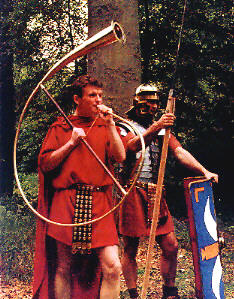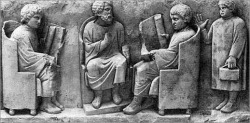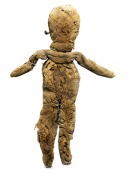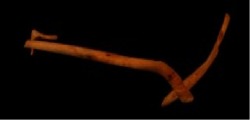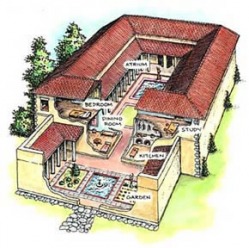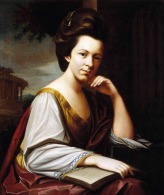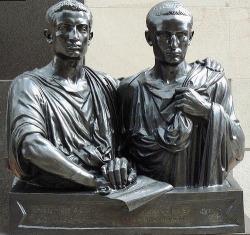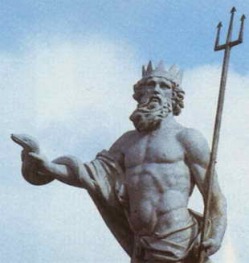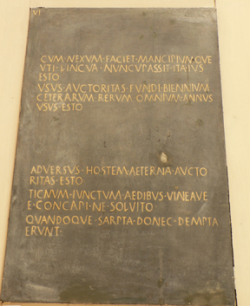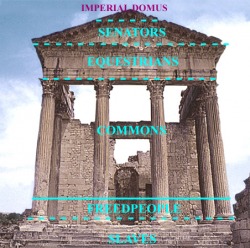Rome
Roman Theater
By: Tom and Jake
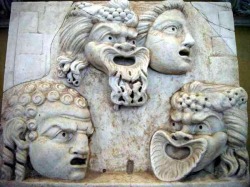
These were similar to the masks woren by actors in the theater
The theater was the roman equivilant to the telelvision. When there was a show you could expect a big crowd. The theater was a place where heart wrenching dramas and humorous comedies were found. Any person could be an actor. There was no discriminating each other as an actor. They could be high, middle, or even lower class. There were two basic types plays back then, there were the "Tragedies" where death and depression were often the ending, and the "Comedies" where there were humorous and slap-stick outcome to the stories. The characters on stage were often in different colored robes to show the different character's society position. Roman theater wasn't always laughter and tears, there was also blood. As entertainment and to help with the realism of the story lines, the actors would often cast criminals and other scoundrels as the villians in the plays. This gave them the excuse to execute them on-stage just as their characters do in the plays.
Roman Music
By: Tom and Jake
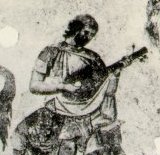
The Lute is the guitar of the ancient world
Rome is known for many of it's historical wonders and achievements, roman music is no exception. Music was, just as everything else was in roman civilization, a culmination of all different styles and beliefs from around the area. There were influences from Egypt, Greece, Gaulo-Keltic, and Persia to name a few. Music could be found all over Rome at all times of the day. There were bards serenading the air with tunes on the lute (such as the one pictured), lyre, and panpipes. Trumpets were played when there were army processions. Flutes were played during religious events. There were a great number of similar instruments we are used to today, such as tubas, flutes, trumpets, drums, tympani, and even organs were all found during the time of the Roman Republic. There is a mystery in all of this though. Archaeologists tell us that these ancient musicians did not just play notes any which way they wanted. They too had sheet music that they followed, but scientist's burning question is: How do you read these darn things!? There has been various pieces of sheet music found scattered all over the roman area. We just don't have any clue how to follow it. The sheet music that we have now is followed on a simple easy to read five staff measure. Without any knowledge of how to read their manuscripts we have no clue which side of the measure to start on!!!
References:
-Cliff, Ursula. "The Roman Theatre". Dickinson College. April 30, 2010 <http://cliojournal.wikispaces.com/The+Roman+Theatre>
-"The Roman Theatre". April 30, 2010 <http://depthome.brooklyn.cuny.edu/classics/dunkle/comedy/romnthtr.htm>.
-"Roman Classical Music". April 30, 2010 <http://www.mmdtkw.org/VRomanMusic.html>.-"Roman Musical Instruments". April 30, 2010 <http://www.aerobiologicalengineering.com/wxk116/Roman/MusicalInstruments/>
References:
-Cliff, Ursula. "The Roman Theatre". Dickinson College. April 30, 2010 <http://cliojournal.wikispaces.com/The+Roman+Theatre>
-"The Roman Theatre". April 30, 2010 <http://depthome.brooklyn.cuny.edu/classics/dunkle/comedy/romnthtr.htm>.
-"Roman Classical Music". April 30, 2010 <http://www.mmdtkw.org/VRomanMusic.html>.-"Roman Musical Instruments". April 30, 2010 <http://www.aerobiologicalengineering.com/wxk116/Roman/MusicalInstruments/>
Roman Republic Language
Kayla Haglund and Claire Warner
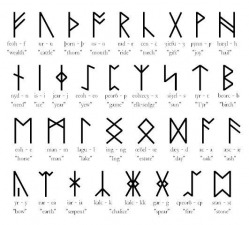
Roman's spoke Latin. This is an example of the Latin alphabet.
Education in the Roman Republic
Kayla Haglund and Claire Warner
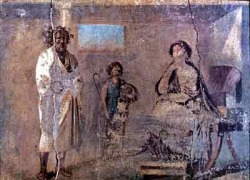
In the early Roman Republic, there was little or no public education for the citizens of Rome. The most basic education was taught by the parents or siblings of each family. The Roman community was very family centered so home schooling was the smart thing to do. Family members would teach each other how to farm, skills in warfare, roman traditions and legends. Other main topics were literature, law, grammar, Latin, math, and music. Boys were mostly taught by their dads while the girls were taught by their moms. These children were taught not only things like math and language but also things they will need to make a living. Young boys were taught to be knowledgeable in public affairs and the laws that were made in the Roman culture. The boys were also taught to swim and the sport of fencing and boxing. They were left in charge of the household so they needed to know the necessary skills to do so. Schooling would end at age twelve for all girls and most boys. Boys that seemed promising or ones that came from rich families would continue schooling after age twelve. The wealthiest families in Rome provided Greek tutors for their children. These boys would now be mostly focusing on Greek and Latin literature. They were taught Greek studies such as rhetoric and philosophy. Poor Romans didn’t have Greek tutors, but they were taught to read and write. Roman Parents saw these as necessary for their children to learn because they would some day be the future leaders of Rome. The girls were trained by their mothers to cook, spin, and weave. The girls were also taught to read and write. As the Roman Republic progressed, education became more and more important. The main goal of education in this time period was to make the children strong, healthy, religious and responsible.
Sources Cited:
"Ancient Latin Alphabet." Latin Central. Hidden Word Originals Ltd., 2005. Web. 30 Apr 2010. http://www.thebookmarkshop.com/latin/latinalphabet.htm.
Kreis, Steven. "Lecture 13 A Brief History of the Roman Empire." The History Guide. Steven Kreis, 4 Aug 2009. Web. 29 Apr 2010. http://www.historyguide.org/ancient/lecture13b.html.
Pillai, Maya. "Ancient Roman Education." Buzzle.com. Buzzle.com, 2010. Web. 29 Apr 2010. http://www.buzzle.com/articles/ancient-roman-education.html.
Roman Republic
Roman Military
By: Drake and Adam
The Roman military was not one you wanted to mess with. They were in a legion which was made up of 5000 men. They were organized into maniples which were made up of 120 men.
These were the different troop types:
Velites- This troop was the youngest and the poorest. They were equipped with a buckler which was a small shield, a gladius which a was a small sword, and a bunch of pila which were javelins. Their job was to protect the main body of the legion and hit the enemy with as many javelins as they could, just to disrupt what the enemy was trying to do. They wore distinctive headgear.
Hastati- The Hastat were also pretty young and poor. They were the front line of the battle, and wore bronze helmets and had a scutum which was a large oval shield. They usually carried spears, but eventually got replaced by pila and a gladius.
Principes- The Principies were behind the Hastati. They were older and usually more experienced, and their equipment was also in better quality because they could afford it.
Triarii- The triarii were the last line of defense. Their equipment was just like the Hastati and the Principies but instead of pila they carried a long thrusting spear. They were veterans and they encouraged the younger troops in the front.
This is how things usually went down with the Roman military:
The velites would throw javelins at the enemy and make them spend time trying to defend that. If the hastati couldn’t break the enemy, they would go to the back with the principies and the triarii. This worked out very good as the last wave was too strong for many armies.
Roman MIlitary, UNRV Duggan, Alfred. The Romans. Canada: Starr, Chester. The Ancient Romans. London:
Updated April 2010 The World Publishing Company Oxford University Press Inc., 1971. 25-35. print.
www.UNRV.com/military.php 1964. 36-52. Print.
Updated April 2010 The World Publishing Company Oxford University Press Inc., 1971. 25-35. print.
www.UNRV.com/military.php 1964. 36-52. Print.
The Life of a Roman Teen
By: Morgan Potter
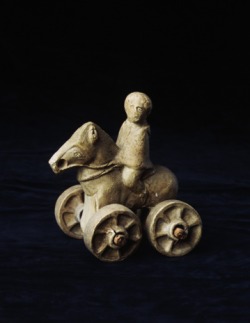
Common Horse and Soldier toy
A teen’s life in the Roman Republic era in many ways was very similar to that of a teen’s now a days. And yet it was in some ways different.
Schooling- In this era children were mostly educated by their parents. They were taught the basic skills such as reading (poetry was a main focus), wrighting, and counting. For those children more privileged than others they might be so lucky as to go to school. These schools consisted of a few select students and one teacher. School did not last long for most and even if schooling did continues most boys (theirs was the only gender that was aloud to continue their education) followed in the footsteps of their fathers.
Toys- Many roman children’s toys were similar to the ones of today. Dolls and dollhouses, little wagons and board games. Many of these toys were homemade. Even the poorest of children had a toy soldier or doll that they could play with. Board games were also quite popular.
Later life- Majority of girls married and went to taking care of their husbands and their new houses. If they did not produce an heir in an acceptable time period the husband had the right to divorce them. Boys followed in the foot steps of their fathers and became apprentices to them.
Schooling- In this era children were mostly educated by their parents. They were taught the basic skills such as reading (poetry was a main focus), wrighting, and counting. For those children more privileged than others they might be so lucky as to go to school. These schools consisted of a few select students and one teacher. School did not last long for most and even if schooling did continues most boys (theirs was the only gender that was aloud to continue their education) followed in the footsteps of their fathers.
Toys- Many roman children’s toys were similar to the ones of today. Dolls and dollhouses, little wagons and board games. Many of these toys were homemade. Even the poorest of children had a toy soldier or doll that they could play with. Board games were also quite popular.
Later life- Majority of girls married and went to taking care of their husbands and their new houses. If they did not produce an heir in an acceptable time period the husband had the right to divorce them. Boys followed in the foot steps of their fathers and became apprentices to them.
Art of the Roman Republic-Beckyn Mickelson and Kayla Patterson
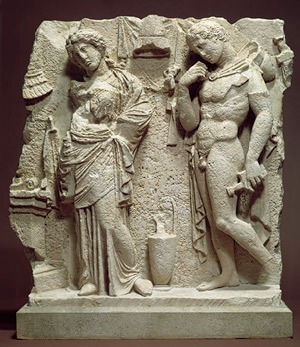
The picture to the left is a grave relief, you can find them during the 4th century BC. They filled the city's cemetary.
The period of the Roman Republic was greatly influenced by the art in Greece, but they put their own twist to it. The people of the Roman Republic believed in praising the dead, so they made many sculptures of people that have already passed away. Many of these sculptures were full sized. This lead to one of the main differences between Roman and Greek art. The Roman believed in making their art more realistic, and the Greek believed in focusing more on ideals.
In the Roman Republic era they also discovered many ways to change art to help them out. First, they realized for the first time that portraits could make propaganda. During the Roman Republic we see Denarius with portait of Julius Caesar. They could be found on their coins. These coins are one way we can figure out what their rulers looked like accurately.
The literature, like the artwork, was greatly influenced by Greece. When the Roman Republic expanded authors began to produce poetry, comedy, and history.
The period of the Roman Republic was greatly influenced by the art in Greece, but they put their own twist to it. The people of the Roman Republic believed in praising the dead, so they made many sculptures of people that have already passed away. Many of these sculptures were full sized. This lead to one of the main differences between Roman and Greek art. The Roman believed in making their art more realistic, and the Greek believed in focusing more on ideals.
In the Roman Republic era they also discovered many ways to change art to help them out. First, they realized for the first time that portraits could make propaganda. During the Roman Republic we see Denarius with portait of Julius Caesar. They could be found on their coins. These coins are one way we can figure out what their rulers looked like accurately.
The literature, like the artwork, was greatly influenced by Greece. When the Roman Republic expanded authors began to produce poetry, comedy, and history.
The Denarius-Beckyn Mickelson and Kayla Patterson
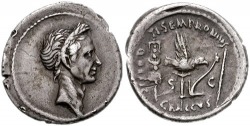
During the Roman Republic we see a Denaris with a portrait of Julius Caesar on it. Julius Caesar issued the coin, it was originally equal to ten asses. The Roman rulers could be found on these coins, which is an accurate way to figure out who the ruler at the time was.
Wall Paintings-Beckyn Mickelson and Kayla Patterson
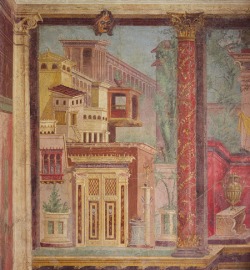
There were three different styles of wall painting during the Roman Republic. The first one was Fresco painting, which was made to look like marble. The second style-artists began to add little things to the imitation marble panels in paintings, like birds of flowers. And the third style, they started added whole scenes to the marble imitated walls.
- REFERENCES-(ART OF THE ROMAN REPUBLIC , WALL PAINTINGS, AND THE DENARIUS)
- Hodge, Susie. "Roman Art". Kidipe. 4-23-10 <http://www.historyforkids.org/learn/romans/art/index.htm>.
- "The Roman Republic". Heilbrunn Timeline of Art History. 4-27-10 <http://www.metmuseum.org/toah/hd/romr/hd_romr.htm>.
- "The Roman Republic". 4-28-10 <"The Roman Republic". Heilbrunn Timeline of Art History. 4-27-10 .>.
- Wheeler, Mortimer. Roman Art and Architecture. New York: Thames and Hudson , 1964.
Farming and Agriculture in the Roman Republic
By Nick Riordan
At the beginning of the Roman Republic, farms were usually very small. Then, during the Second Punic War, the Carthaginian general Hannibal used scorched earth tactics to destroy the Romans' food supply. After the war was won, the small farms of the past gave way to large ranches worked by slaves. The slaves here were on three levels: The steward, who ran the farm, the field foreman, who supervised the field workers, and the field workers. The Romans' convenient location near the Mediterranean allowed them to grow good crops year-round. Their crop supply usually consisted of grapes, wheat, and olives. To plow the fields, the Romans used an ard. This process was done very precisely, twice at directions in right angles to each other in order to create a flat surface. Oxen were used to draw the plow due to the heavy soil and the presence of roots and vines. They built large dams and reservoirs for irrigation. The reservoirs were lined with waterproof cement and sometimes had an area of two thousand meters. To maintain their fields, they rotated their crops every few years to reduce weed growth and hoed and weeded much like what it is seen today in some communities. They also used their farm animals to replenish the farmland with their waste. Their cattle regularly grazed on fallow land. When harvesting, the Romans modified the basic sickle by angling the handle to reduce strain on the wrist.
Paragraph.
The Romans also left their mark on the world of livestock. They used animals such as oxen, goats, donkeys, sheep, and fancy birds like ducks and peacocks. The Romans taught their oxen how to properly pull a plow and at the correct speed. Though not nearly as drastic as the ancient Sybarites, who taught their horses to dance, it is still a very difficult thing to do. Mules and donkeys also did work. The ducks and peacocks were kept in ponds or aviaries, which are large cages or houses for birds. They were reared with great care because of their gourmet status. Also, goats and sheep were used for the Romans' milk and meat supply as well as goat's hair for rope and wool from the sheep. They were also shepherded seasonly between lowlands an adjacent mountains in a process called transhumance. The sheep and goats were sent up in the mountains for the summer while the lowlands were being used for farming and rested in the lowlands during the winter due to less agreeable conditions in the mountains and to leave their manure on the fields. This process favored Italy's climate and geography very well. They could be moved up and down a single valley, or, as a more extreme example, from Apulia, a plain in southeastern Italy, to the Apennine Mountains, which run through the center of the Italian Peninsula, a distance of over two hundred miles!
The Romans were also the first civilization to breed their animals for better traits, a process still used today. And they also built one of the first of a different kind of farm: a saltwater fish farm. These were made in approximately 95 BCE, with tanks fed with seawater by a channel. They also cultivated oysters and sea snails, but this eventually became more of a leisure activity than a food source.
The Romans were also the first civilization to breed their animals for better traits, a process still used today. And they also built one of the first of a different kind of farm: a saltwater fish farm. These were made in approximately 95 BCE, with tanks fed with seawater by a channel. They also cultivated oysters and sea snails, but this eventually became more of a leisure activity than a food source.
WORKS CITED
Boardman, John, Jasper Griffin, and Oswyn Murray. Oxford Illustrated History of the Modern World. Oxford, England: Oxford U. Press,
Reissued 2001.
Rymer, Eric. "Roman Farming". Corel Family of Products. April 22, 2009 <http://historylink101.com/lessons/farm-city/rome1.htm>.
"Explore: Rome - Agriculture". The Gift of Prometheus: Sciences of Ancient Civilizations. April 24, 2009
<http://library.thinkquest.org/C0122667/rome/agri.html>.
Reissued 2001.
Rymer, Eric. "Roman Farming". Corel Family of Products. April 22, 2009 <http://historylink101.com/lessons/farm-city/rome1.htm>.
"Explore: Rome - Agriculture". The Gift of Prometheus: Sciences of Ancient Civilizations. April 24, 2009
<http://library.thinkquest.org/C0122667/rome/agri.html>.
Housing
By: Morgan Potter
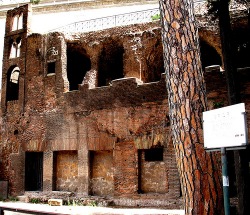
Apartment above shop
The housing in the Roman Republic Era were split, as it often was in that era, into upper and lower class. The more money you had the bigger and better your house would be. In the busy city of Rome, many of its ocupents owned or worked in shops that surrounded the city. So, it was only logical that many of those people lived in apartments above thier shops. Another common dwelling was in small 1 or 2 room town houses. As for the wealthier of Romes society, many of them lived in stately houses called Villas. A villa was a farm or orchard with a large house (villa) attached. Unlike the small, cramped apartments in the city, these large and spacious homes included an atrium, dining room/kitchen, more than one bedroom, library, bath house, and a courthouse. Like the ocupants of the apatments in the city these people lived were they worked. Majority of people who lived in the villas owned and operated.
Dress and Hair in the Roman Republic
By: Morgan Potter
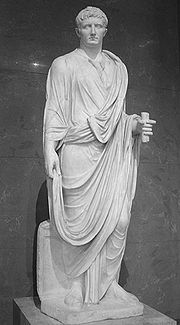
Emperor Augustus in Toga and traditional 'Caesar' haircut
Dress-When we think of the Roman era we see men and women is sweeping white toga. And thats just what they wore. While we all think white is the traditional color, this is not true. Different colored togas represent different jobs and status.
White: Wore by political canidates to show they were honest and pure.
Dark Grey or Brown: These were sings of mourning.
Purple: In Roman society purple was a royal color and the high socitey wore this color with golden embelishments.
While most Togas were heary and hot, the lower class wore shorter "tunics" wich resembled a tong t-shirt tied at the waist. Tunics were worn mainly by slave or gladiators. Togas were beautifully represented in this eras sculptures and murals. Men of Power frequently worn their armor to any important event or in public.
As for Jewelry, many people, Even those of high rank, did not wear much jewelry. On of the only pieces that was always worn (mainly by men) were rins with symbols that they could use to make impressions in wax to seal envelopes. There were also decorative pins and broches that were used to hold the many fold of the Togas in place. Women may also wear the occational necklace and earings along with jeweled hair pins.
Hair- Men had it easy as far as hair went. They had very very close cut hair. This cut, now called "the Caeser" is still worn by many men of today. Some of the more famous men sporting the Caesar are George Clooney, Russell Crowe *for his role in the movie The Gladiator*, and even Eminem!
Womens hair was much more elabrorate (and longer for that matter) Women doned long long tresses that they swept up into complicated updos. A very interesting piece of information that I found in my resear was that the hairstylings in the time of Marie Antionette and Georgian Cavendish were inspired by those of the Roman time period. Truth is that when you compair art from the two different time periods they are actually quite similar. Curly, long hair swept up to the top of the head with a few curls that framed the face or fell in the back. In the Roman era women used bands, bejewled pins and chains to decorate their hair.
White: Wore by political canidates to show they were honest and pure.
Dark Grey or Brown: These were sings of mourning.
Purple: In Roman society purple was a royal color and the high socitey wore this color with golden embelishments.
While most Togas were heary and hot, the lower class wore shorter "tunics" wich resembled a tong t-shirt tied at the waist. Tunics were worn mainly by slave or gladiators. Togas were beautifully represented in this eras sculptures and murals. Men of Power frequently worn their armor to any important event or in public.
As for Jewelry, many people, Even those of high rank, did not wear much jewelry. On of the only pieces that was always worn (mainly by men) were rins with symbols that they could use to make impressions in wax to seal envelopes. There were also decorative pins and broches that were used to hold the many fold of the Togas in place. Women may also wear the occational necklace and earings along with jeweled hair pins.
Hair- Men had it easy as far as hair went. They had very very close cut hair. This cut, now called "the Caeser" is still worn by many men of today. Some of the more famous men sporting the Caesar are George Clooney, Russell Crowe *for his role in the movie The Gladiator*, and even Eminem!
Womens hair was much more elabrorate (and longer for that matter) Women doned long long tresses that they swept up into complicated updos. A very interesting piece of information that I found in my resear was that the hairstylings in the time of Marie Antionette and Georgian Cavendish were inspired by those of the Roman time period. Truth is that when you compair art from the two different time periods they are actually quite similar. Curly, long hair swept up to the top of the head with a few curls that framed the face or fell in the back. In the Roman era women used bands, bejewled pins and chains to decorate their hair.
Citation-Morgan Potter
Osborn Tracy. "Teacher Oz's Kingdom of History- Ancient Rome". N.p., 22 07 2003. Web. 20 Apr 2010. <www.teacheroz.com/ancientrome.htm>.
McManus Barbara. "Roman Clothing" N.p., 07 2003. Web. 28 Apr 2010. <vromaorg/~bmcmanus/clothing.html>.
Unknown, . "Romans: Family and Children." BBC, Unknown Date. Web. 25 Apr 2010. <www.bbc.uk/schools/primaryhistory/romans/family_and_children
McManus Barbara. "Roman Clothing" N.p., 07 2003. Web. 28 Apr 2010. <vromaorg/~bmcmanus/clothing.html>.
Unknown, . "Romans: Family and Children." BBC, Unknown Date. Web. 25 Apr 2010. <www.bbc.uk/schools/primaryhistory/romans/family_and_children
M. Porcius Cato
By Andrea Schoenenberger and Morgan Arndt
Cato was a 2nd century B.C. Roman politician, general, and writer austre way of life and rigid principals. Cato's family originally came from Tusculum, but he spent the early part of his life in Sabine territory. He first entered the millitary at age 17, when Hannibal invaded Italy. Cato gained a local reputation as a poublic speaker in the law courts. This brought him attention of L. Valerius Flaccus, who encouraged him to seek public office in Rome. Cato was praetor in 198 and appointed governor of Sardinia, which he ruled very strictly. The local people were relieved at not having to support a large entourage as had been the case under previous governors, but dreaded the possibility of having answer for any wrong doings. In the war against Antichus lll Epiphanes, Cato lead a detachment of Firmani in a surprise attack on the rear of Antiochus position at Thermopylae,. and was mainly responsible for the route of Antichus' army. Cato was sent back to Rome with the news of the armys success and Victory. Cato assisted in the prosecution of Scipio and, after Scipio's death, his brother L. Scipio Asiaticus in 187. in 185, Cato announced his candidacy for the censorship in 184. seven candidates were persuaded to stand against him, but Cato won the election. Cato also increased taxes on luxery items and cracked down on theose who had diverted part of the public water supply into their own houses and those whose houses encroached on public land . He also tried to reduce the prices charged to the state by contractors for public works programmers, and increase the price paid to the state by tax farmers.
The Gracchi Brothers
By Andrea Shoenenberger and Morgan Arndt
The emergence, and eventual assassination of the Gracchus brothers, Tiberius and Gaius, is often considered the first major step towards the fall of the Roman Republic. The brothers themselves were members of the highest Patrician order of Rome. Thier father was consul and their mother was of the distinguished Scipio family. Tiberius started his political career under the wings of C. Scipio Amelianus but later was to be opposed by the powerful senatorial elite of which he was originally a member. The careers of these two men were marked by riots, murder, and ultimately, outright manipulation of the common population to achieve their goals. From 137 to 121 BC, Tiberius, and then Gaius Gracchus, stood at the center of this turmoil. The recent conquests had opened many doors to new found wealth, but the rapid pace of such expansion opened more doors to corruption and mismanagement. The lack of new recruits from among the landowning class was beginning to take its toll. Small farms were slowly driven into extinction as the wealthy bought up land and resources for vast estates. Laws preventing the Legions from taking the landless as recruits were certainly an issue. These displaced Roman's had no farms and no opportunities to regain their status through military service. Governing all the new provinces was a strain at best, without a large recruiting base of small landowners. Tiberius and Gaius Gracchus saw an opportunity not only to achieve their own political power, but to stabilize the inequality through reform and new laws benefiting the common One-upmanship was countered with arguments and these countered with physical force. As the results at stake grew, so did the egos of the individual players. The goal of the betterment of society as a whole was lost, and victory became the only objective. As ambition and personal motivation became the predominant theme of the Late Republic, the social fabric that long held Rome together, against all odds, was being torn apart.people. Reasonable and noble concepts on the surface, however, were underlying with their own contempt for the Senate and optimate party.
Marcus Janius Brutus
By Andrea Schoenenberger and Morgan Arndt
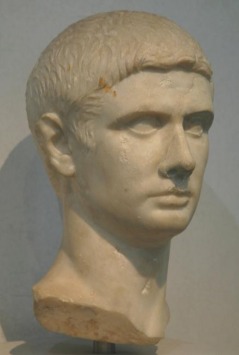
Brutus was the son of Marcus Junius Brutus, a relatively unimportant politician, and Servilia Caepionis, half-sister of Cato the younger and mistress of Julius Caesar. Some sources refer to the possibility of Caesar being his real father. Brutus’ uncle Servilius Caepio adopted him when he was a young man and Brutus added his cognomen to his own name. His political career started when he became an assistant of Cato, during Cato's governorship of Cyprus. During this time, he enriched himself by loaning money to desperate persons at high rates of interest. From his first appearance in the senate, Brutus aligned with the Optimates (the conservative faction) against the First Triumvirate of Marcus Licinius Crassus, Pompey, and Julius Caesar. He had everything to hate in Pompey, who had his father murdered in 77 BC, during the prosecutions by Sulla.
When civil war broke in 49 BC between Pompey and Caesar, Brutus followed his old enemy and present leader of the Optimates, Pompey. After the disaster of the Battle of Pharsalus, Brutus wrote Caesar with apologies and Caesar immediately forgave him. Caesar accepted him into his inner circle and made him governor of Gaul when he left for Africa in pursuit of Cato and Metellus Scipio. In the next year (45 BC), Caesar nominated him to be a praetor.Brutus, like many other senators, was not satisfied with the state of the Republic. Caesar had been made dictator for life and was approving legislation to concentrate power in his own hands. Together with his friend and brother-in-law Cassius and other men, Brutus started to conspire against Caesar. On the Ides of March (March 15) of 44 BC, a group of senators including Brutus murdered Caesar on the steps of Pompey's Theater.
The conspirators received a temporary amnesty from Marcus Antonius who was now the head of state. However, the city itself was against them, because most of the population loved Caesar dearly. Antonius decided to make use of the circumstances and, on March 20 spoke angrily against the assassins during Caesar's funeral eulogy. Since Rome no longer saw them as saviours of the Republic and they were facing treason charges, Brutus and his fellow conspirators fled to the East.
In Athens, Brutus dedicated himself to the study of philosophy and, no less importantly, to the raising of funds and levying of soldiers to form legions. Antonius and Caesar's adopted son Octavianus were certain to come after him and Cassius searching for revenge. The armies of Antonius and Octavianus appeared in the summer of 42 BC. On October 3, the First Battle of Philippi did not produce a decisive result. Brutus' men defeated Octavianus, but Antonius defeated Cassius. Cassius then committed suicide without knowing of his ally's victory. Both armies regrouped and fought the Second Battle of Philippi on October 23. According to Plutarch and Suetonius, Brutus was afflicted by dreams of Caesar and other omens foretelling his defeat and his spirits were very low. This time Octavianus and Antonius were the uncontested winners. Brutus managed to escape but did not travel very far. His friends urged him to escape once more, but he replied with one of his most famous quotes: Escape, yes, but this time with the hands, not with the feet. After saying this, he committed suicide.
When civil war broke in 49 BC between Pompey and Caesar, Brutus followed his old enemy and present leader of the Optimates, Pompey. After the disaster of the Battle of Pharsalus, Brutus wrote Caesar with apologies and Caesar immediately forgave him. Caesar accepted him into his inner circle and made him governor of Gaul when he left for Africa in pursuit of Cato and Metellus Scipio. In the next year (45 BC), Caesar nominated him to be a praetor.Brutus, like many other senators, was not satisfied with the state of the Republic. Caesar had been made dictator for life and was approving legislation to concentrate power in his own hands. Together with his friend and brother-in-law Cassius and other men, Brutus started to conspire against Caesar. On the Ides of March (March 15) of 44 BC, a group of senators including Brutus murdered Caesar on the steps of Pompey's Theater.
The conspirators received a temporary amnesty from Marcus Antonius who was now the head of state. However, the city itself was against them, because most of the population loved Caesar dearly. Antonius decided to make use of the circumstances and, on March 20 spoke angrily against the assassins during Caesar's funeral eulogy. Since Rome no longer saw them as saviours of the Republic and they were facing treason charges, Brutus and his fellow conspirators fled to the East.
In Athens, Brutus dedicated himself to the study of philosophy and, no less importantly, to the raising of funds and levying of soldiers to form legions. Antonius and Caesar's adopted son Octavianus were certain to come after him and Cassius searching for revenge. The armies of Antonius and Octavianus appeared in the summer of 42 BC. On October 3, the First Battle of Philippi did not produce a decisive result. Brutus' men defeated Octavianus, but Antonius defeated Cassius. Cassius then committed suicide without knowing of his ally's victory. Both armies regrouped and fought the Second Battle of Philippi on October 23. According to Plutarch and Suetonius, Brutus was afflicted by dreams of Caesar and other omens foretelling his defeat and his spirits were very low. This time Octavianus and Antonius were the uncontested winners. Brutus managed to escape but did not travel very far. His friends urged him to escape once more, but he replied with one of his most famous quotes: Escape, yes, but this time with the hands, not with the feet. After saying this, he committed suicide.
Gaius Julius Caesar
By Andrea Schoenenberger and Morgan Arndt
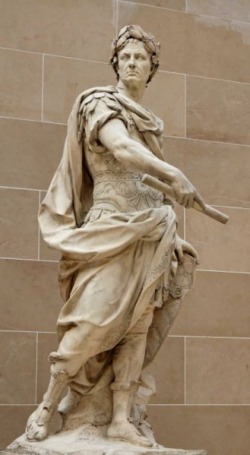
Caesar played a critical role in the transformation of the Roman Republic in to the Roman Empire. As a politician, Caesar made us of popularist tactics. During the late 60's and into the 50's B.C, he formed political alliances that led to the so-called First Triumvirate, an extra-legal arrangement eithe Marcus Licinius Crassus and Gnaeus Pompeius Magnus (pompey the great) that was to dominate Roman politics for several years. their Factional attempts to amass power for themselves were opposed within the Roman Senate by the optimates, among them Marcus Porcius Cato and Marcus Calpurnius Bibulus, with the sometime support of Marcus Tullius Cicero. Caesar's conquest of Gaul extended the Roman world to the North Sea, and in 55 BC he also conducted the first Roman invasion of Britain. These achievements granted him unmatched military power and threatened to eclipse Pompey's, while the death of Crassus contributed to increasing political tensions between the two triumviral survivors. Political realignments in Rome finally led to a stand-off between Caesar and Pompey, the latter having taken up the cause of the Senate. With the order that sent his legions across the Rubicon, Caesar began a civil war in 49 BC from which he emerged as the unrivaled leader of the Roman world.
After assuming control of government, he began extensive reforms of Roman society and government. He centralised the bureaucracy of the Republic and was eventually proclaimed "dictator in perpetuity" (dictator perpetuo). A group of senators, led by Marcus Junius Brutus, assassinated the dictator on the Ides of March (15 March) 44 BC, hoping to restore the normal running of the Republic. However, the result was another Roman civil war, which ultimately led to the establishment of a permanent autocracy by Caesar's adopted heir, Gaius Octavianus. In 42 BC, two years after his assassination, the Senate officially sanctified Caesar as one of the Roman deities.
Much of Caesar's life is known from his own Commentaries (Commentarii) on his military campaigns, and other contemporary sources such as the letters and speeches of his political rival Cicero, the historical writings of Sallust, and the poetry of Catullus. Many more details of his life are recorded by later historians, such as Appian, Suetonius, Plutarch, Cassius Dio and Strabo.
After assuming control of government, he began extensive reforms of Roman society and government. He centralised the bureaucracy of the Republic and was eventually proclaimed "dictator in perpetuity" (dictator perpetuo). A group of senators, led by Marcus Junius Brutus, assassinated the dictator on the Ides of March (15 March) 44 BC, hoping to restore the normal running of the Republic. However, the result was another Roman civil war, which ultimately led to the establishment of a permanent autocracy by Caesar's adopted heir, Gaius Octavianus. In 42 BC, two years after his assassination, the Senate officially sanctified Caesar as one of the Roman deities.
Much of Caesar's life is known from his own Commentaries (Commentarii) on his military campaigns, and other contemporary sources such as the letters and speeches of his political rival Cicero, the historical writings of Sallust, and the poetry of Catullus. Many more details of his life are recorded by later historians, such as Appian, Suetonius, Plutarch, Cassius Dio and Strabo.
Pompey the Great
By Andrea Schoenenberger and Morgan Arndt
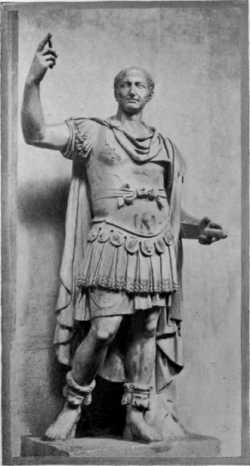
At the age of twenty-six Gnaeus Pompeius is considered such a brilliant general that his own troops, after a campaign in Africa in 80 BC, call him Pompeius Magnus - Pompeius the Great - in a flattering echo of Alexander the Great. In English he is known more simply as Pompey. Pompey's military reputation continues to grow and in 67 BC he is entrusted with an important mission - to rid the Mediterranean of the pirates who are terrorising coastal regions and ruining Rome's trade. They are said to have as many as 1000 ships in their combined fleets. In view of the evident difficulty of the task, the senate gives Pompey three years to complete it.
This success brings Pompey, in 66 BC, an even more important command. He is to take charge of the Roman legions in Asia Minor. The entire eastern Mediterranean, from Anatolia through Syria to Palestine, is in a state of unrest and anarchy. His task is to bring it under control.
Again he achieves his purpose with great skill. Anatolia is subdued. Syria is annexed in 64 BC as a Roman province. Phoenicia and Palestine are soon merged with it, though Jerusalem only falls to him after a three-month siege.
Throughout the region Pompey establishes administrative systems which will preserve peace in the coming years. They will also bring in vast new quantities of annual tax. When Pompey enjoys his triumph in Rome, in September of 61 BC, the quantity of gold and bullion dragged along in his procession is greater than any general has brought home before. It is sufficient to provide a generous bounty for his soldiers and still leave much for the treasury. On bringing his victorious fleet and army into Brindisi, late in 62 BC, Pompey has dismissed his legions in the correct manner - it is illegal for Roman generals to bring their armies on to Italian soil. But there is, as always on such occasions, an implicit understanding between the legionaries and their leader; he will use his influence to provide plots of land on which they can support themselves.
Pompey, Crassus and Caesar all have grievances against the senate. Caesar, elected consul for the coming year, 59 BC, could normally expect a provincial governorship; instead he has been given the supervision of Italy's forests and cattle trails. Pompey has not been allowed the land which he needs for the disbanded veterans of his army. Crassus has been frustrated in a profitable tax-collecting venture in Asia.
The three men form, in 60 BC, what is now known as the first triumvirate. To cement the link, Pompey marries in 59 Caesar's only child, Julia (though he is older than her father). With equal cynicism, selective rioting by Pompey's veterans is used to persuade the senators to change their minds.
Land is found for the veterans. These two are now the most powerful men in the republic. As allies they are unbeatable. The underlying question is how long it will be before they emerge, in truer colours, as rivals.
The senators in Rome, alarmed by Caesar's successes in Gaul, incline towards Pompey as their best protection. In an attempt to clip Caesar's wings, the senate instructs him, in December of the year 50 BC, to give up his command of Gaul and to return to Rome as a private citizen.
Quite apart from his disregard of the senate's instructions, it is against the law for any commander to bring a Roman army outside the province to which he and it are assigned. In crossing the Rubicon, Caesar consciously and irrevocably launches a civil war.Pompey escapes the immediate danger by embarking a large army in a fleet of ships and retreating across the Adriatic to Greece. Caesar pursues him there and eventually defeats him at Pharsalus, in the summer of 48 BC.
Pompey flees again, this time to Egypt.
Bamilcar Barca
Where Hamilcar Barca was a great Carthaginian general and statesman in the First Punic War who firmly established Carthaginian rule in Spain. Barca was a daring, intelliggent young man. He was appointed commander in chief in Sicily in 247 B.C., when, after 18 years of fighting, the Carthaginian forces were at their lowest, entrusted
with naval operations, he immediatly set out to attack and ravage the coastline of Lucania and Bruttium. He then landed on the north caost of Sicil, seizing Mt. Hercte west of Panormous. From this vantage point he hoped to strike at the rear of the armies besieging Lily-baeum and Ponormus. Meanwhile, he fortified the site, buit a harbor for his fleet, and continued thhe raids on the Italian coast. After 3 years of harassing the Romans and hholding them at bay, Hamilcar was finally dislodged from Mt. hercte, he cptured the city of Eryx, thus driving a wedge between the Romans who occupied the Temple of Venus on top of Mt. Eryx and the army that besieged drepanum. From this new strategitx point Hamilcar set out with his fleet and continued to devastate the Sicilian and Italian shores. Hamilcar's home government gave him full power t negotiate the best possible terms of peace with Roman victor. Acting as a good and prudent leader, Hamilcar drew up a treaty with Lutatius, which, even though not fully accepted by the Roman people put an end to the punic war.Hamilcar receivd free retreat for his troops , transfered them from Mt. Erys to Lilybaeum, and laid down his commander
This success brings Pompey, in 66 BC, an even more important command. He is to take charge of the Roman legions in Asia Minor. The entire eastern Mediterranean, from Anatolia through Syria to Palestine, is in a state of unrest and anarchy. His task is to bring it under control.
Again he achieves his purpose with great skill. Anatolia is subdued. Syria is annexed in 64 BC as a Roman province. Phoenicia and Palestine are soon merged with it, though Jerusalem only falls to him after a three-month siege.
Throughout the region Pompey establishes administrative systems which will preserve peace in the coming years. They will also bring in vast new quantities of annual tax. When Pompey enjoys his triumph in Rome, in September of 61 BC, the quantity of gold and bullion dragged along in his procession is greater than any general has brought home before. It is sufficient to provide a generous bounty for his soldiers and still leave much for the treasury. On bringing his victorious fleet and army into Brindisi, late in 62 BC, Pompey has dismissed his legions in the correct manner - it is illegal for Roman generals to bring their armies on to Italian soil. But there is, as always on such occasions, an implicit understanding between the legionaries and their leader; he will use his influence to provide plots of land on which they can support themselves.
Pompey, Crassus and Caesar all have grievances against the senate. Caesar, elected consul for the coming year, 59 BC, could normally expect a provincial governorship; instead he has been given the supervision of Italy's forests and cattle trails. Pompey has not been allowed the land which he needs for the disbanded veterans of his army. Crassus has been frustrated in a profitable tax-collecting venture in Asia.
The three men form, in 60 BC, what is now known as the first triumvirate. To cement the link, Pompey marries in 59 Caesar's only child, Julia (though he is older than her father). With equal cynicism, selective rioting by Pompey's veterans is used to persuade the senators to change their minds.
Land is found for the veterans. These two are now the most powerful men in the republic. As allies they are unbeatable. The underlying question is how long it will be before they emerge, in truer colours, as rivals.
The senators in Rome, alarmed by Caesar's successes in Gaul, incline towards Pompey as their best protection. In an attempt to clip Caesar's wings, the senate instructs him, in December of the year 50 BC, to give up his command of Gaul and to return to Rome as a private citizen.
Quite apart from his disregard of the senate's instructions, it is against the law for any commander to bring a Roman army outside the province to which he and it are assigned. In crossing the Rubicon, Caesar consciously and irrevocably launches a civil war.Pompey escapes the immediate danger by embarking a large army in a fleet of ships and retreating across the Adriatic to Greece. Caesar pursues him there and eventually defeats him at Pharsalus, in the summer of 48 BC.
Pompey flees again, this time to Egypt.
Bamilcar Barca
Where Hamilcar Barca was a great Carthaginian general and statesman in the First Punic War who firmly established Carthaginian rule in Spain. Barca was a daring, intelliggent young man. He was appointed commander in chief in Sicily in 247 B.C., when, after 18 years of fighting, the Carthaginian forces were at their lowest, entrusted
with naval operations, he immediatly set out to attack and ravage the coastline of Lucania and Bruttium. He then landed on the north caost of Sicil, seizing Mt. Hercte west of Panormous. From this vantage point he hoped to strike at the rear of the armies besieging Lily-baeum and Ponormus. Meanwhile, he fortified the site, buit a harbor for his fleet, and continued thhe raids on the Italian coast. After 3 years of harassing the Romans and hholding them at bay, Hamilcar was finally dislodged from Mt. hercte, he cptured the city of Eryx, thus driving a wedge between the Romans who occupied the Temple of Venus on top of Mt. Eryx and the army that besieged drepanum. From this new strategitx point Hamilcar set out with his fleet and continued to devastate the Sicilian and Italian shores. Hamilcar's home government gave him full power t negotiate the best possible terms of peace with Roman victor. Acting as a good and prudent leader, Hamilcar drew up a treaty with Lutatius, which, even though not fully accepted by the Roman people put an end to the punic war.Hamilcar receivd free retreat for his troops , transfered them from Mt. Erys to Lilybaeum, and laid down his commander
Spartacus
By Andrea Schoenenberger and Morgan Arndt
Spartacus was born in Thrace of Greece in 109 B.C.E. He later became an auxiliary in the army. But he committed some crime and as punishment was sold as a slave. A Roman by the name of Lentulus Batiatus bought Spartacus and put him in his gladiator school in Capua. Spartacus was put in the Familia (troupe of gladiators) called Famalia Batiatus. The school was basically a prison for the gladiators when they were not fighting. In 73 B.C.E. Spartacus lead the other gladiators to freedom of the school by using kitchen knives to kill the guards. They escaped to Mount Vesuvius. They formed an army of which Spartacus led, and soon were joined by more escaped slaves. The Senate of Rome sent 3,000 soldiers led by Clodius Glaber to stop the revolt. Glaber's camp was not fortified properly and was attacked by the slave army. Spartacus' surprise attack caused Glaber a humiliating loss. The slave army grew again to 30,000. The Senate of Rome sent two more consuls with a Roman legion each the bring down the slave army. Gnaeus Cornelius Lentulus Clodianus is defeted by Spartacus's group of slaves but Gellius Publicola defeats Spartacus's second troup led by Crixus. Gellius does not live in victory for long before Spartacus defeats him and his army. Spartacus later defeats two more Roman legions. Crassus was in charge of those troups and tries to trap the slave army in the 'toe' of Italy. His attemp at a wall to hold the slave army in became pointless when Spartacus breaks through the defense lines and goes to Brundisium. Crassus met Spartacus in Lucania and the two armies fought Spartacus' last battle. His death was the end of the Third Servile War.
References
- http://www.roman-colosseum.info/gladiators/biography-on-spartacus.htm
- http://www.unrv.com/empire/tiberius-gracchus.php
- http://ancienthistory.about.com/cs/people/a/catotheelder.htm
Other People of Interest
P. Cornelius Scipio Africanus Major
- http://www.economicexpert.com/a/Publius:Cornelius:Scipio:Africanus:Major.htm
L. Aemilius Paullus Macedonicus
- http://ancienthistory.about.com/cs/people/a/aemiliuspaullus.htm
Cn Marcius Coriolanus
- http://www.livius.org/man-md/marcius/coriolanus.html
Gaius Marius
- http://www.unrv.com/empire/gaius-marius.php
Lucius Cornelius Sulla
- http://www.unrv.com/empire/lucius-cornelius-sulla.php
References
- http://www.roman-colosseum.info/gladiators/biography-on-spartacus.htm
- http://www.unrv.com/empire/tiberius-gracchus.php
- http://ancienthistory.about.com/cs/people/a/catotheelder.htm
Other People of Interest
P. Cornelius Scipio Africanus Major
- http://www.economicexpert.com/a/Publius:Cornelius:Scipio:Africanus:Major.htm
L. Aemilius Paullus Macedonicus
- http://ancienthistory.about.com/cs/people/a/aemiliuspaullus.htm
Cn Marcius Coriolanus
- http://www.livius.org/man-md/marcius/coriolanus.html
Gaius Marius
- http://www.unrv.com/empire/gaius-marius.php
Lucius Cornelius Sulla
- http://www.unrv.com/empire/lucius-cornelius-sulla.php
Transportaion
By: Brittany Saulsgiver
Sports/Athelitics by Joe and Lee
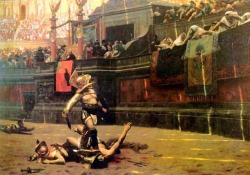
Gladiators
Gladiators were fighters in Rome. They fought other gladiators, animals, and even slaves. They sometimes fought to the death for the entertainment of the viewers. The word 'gladiator' comes from gladius, the Latin word for a short sword used by some gladiators. Gladiatorial games were thought to be established by the Etruscans, and were adopted by the Romans. The first recorded fight occurred in Rome in 264 B.C.E. Early on, Gladiatorial battles were held by private individuals looking for popularity, later the political leaders would organize them.
Gladiators were often selected from lower class citizens, prisoners of war, slaves, or criminals. Sometimes the gladiators were owned by wealthy people who paid them to fight. If criminals were made into gladiators, they had the chance to be free if they survived three years. Gladiators would fight no more than three times a year.
Gladiators usually fight in large stadiums or amphitheaters. These stadiums were very large open stadiums with a 'pit' in the center where the gladiators and other creatures entered and fought.
Spartacus was a famous Gladiator who led a revolt in 73 B.C.E. His group existed of slaves and run away criminals. They were ultimately smashed two years later. This revolt resulted in Gladiator battles being outlawed during social disturbances.
Gladiators fought wearing different armor and using different weapons. T
Naval Battles
Late in the Roman Republic, naval battles were created. Julius Caesar organized one of the first battles in 46 B.C.E. The battle occurred in a dug out lake. A few naval battles even occurred in the Colosseum. The fights in the Colosseum were called Naumachiae. Naumachiae fights occurred after the Romans have established their naval power. In the Colosseum it is possible that the battles were more of a rowing race, not a fight to the death.
Public Baths
Public baths were like modern day swimming pools, workout centers, or spas. First, you would go lift weights, then go sit in a hot pool, then a warm pool, then a cold pool, then finally you would get a massage and go home.
Campus
Almost every city had a place called a Campus. The Campus was converted from a soldier training ground to a track and field stadium. Events included foot racing, jumping, archery, wrestling, and boxing. After exercising, most would bathe in some sort of way and relax. People also participated in fencing, riding, throwing, and swimming. Men went fishing and hunting in the country. Men played ball before dinner, but women were not allowed to participate.
Ball Games
Sports with balls were very popular in Rome. Many people spent morning playing various ball games. Ball games included Handball, Trigon, Soccer, Field Hockey, Harpasta, Phaininda, Episkyros, Dodgeball, and Catch. Children would also create games. Team Soccer may not have occurred, but for sure they kicked balls around in the streets and on the fields.
Board Games
Board games were very popular in Rome. Some games played were Knucklebones, Dice, Roman Chess, Roman Checkers, The Game of Twelve Lines, The Game of Lucky Sixes, Tic-Tac-Toe, Roman Backgammon, and Egyptian Backgammon.
References
Wiedemann, Thomas: Emperors and Gladiators, Routledge 1992
James Grout: Gladiators, part of the Encyclopædia Romana
Violence and the Romans: The Arena Spectacles (http://janusquirinus.org/essays/Arena.html)
The Revolt of Spartacus (http://nefer-seba.net/essays/Spartacus/) A narrative essay.
Daniel P Mannix: "Those About To Die", Ballantine Books, New York 1958
No Author. Ancient Roman Recreation & Sports. http://www.crystalinks.com/romerecreation.html.
www.mariamilani.com/colosseum/colossuem_naumachiae.html.
http://chalk.richmond.edu/education/projects/webunits/greecerome/Romesports1.html.
Gladiators were fighters in Rome. They fought other gladiators, animals, and even slaves. They sometimes fought to the death for the entertainment of the viewers. The word 'gladiator' comes from gladius, the Latin word for a short sword used by some gladiators. Gladiatorial games were thought to be established by the Etruscans, and were adopted by the Romans. The first recorded fight occurred in Rome in 264 B.C.E. Early on, Gladiatorial battles were held by private individuals looking for popularity, later the political leaders would organize them.
Gladiators were often selected from lower class citizens, prisoners of war, slaves, or criminals. Sometimes the gladiators were owned by wealthy people who paid them to fight. If criminals were made into gladiators, they had the chance to be free if they survived three years. Gladiators would fight no more than three times a year.
Gladiators usually fight in large stadiums or amphitheaters. These stadiums were very large open stadiums with a 'pit' in the center where the gladiators and other creatures entered and fought.
Spartacus was a famous Gladiator who led a revolt in 73 B.C.E. His group existed of slaves and run away criminals. They were ultimately smashed two years later. This revolt resulted in Gladiator battles being outlawed during social disturbances.
Gladiators fought wearing different armor and using different weapons. T
- Andabatae: Fought on horseback possibly blindfolded or with visors.
- Cimachaeri: Used two short swords (the gladius)
- Bestiari: Fought against beasts, usually with spears.
- Equites: Fought with spears and gladius on horseback, dressed in a full tunic, with a manica (arm-guard)
- Essedari: Charioteers in Celtic style.
- Hoplomachi: Fully armored, based on Greekhoplites. They wore a stylized griffin crested helmet, woollen leg wrappings, and shin-guards. They carried a gladius and a small, round shield, and were paired with Thraces. They apparently became Samnites later.
- Laquerii: Lasso Laqueatores were those who used a noose to catch their adversaries
- Mirmillones (or murmillones): Wore a stylized fish crested helmet, as well as a manica. They carried a gladius and an oblong shield in the Gallic style. They were paired with Thraces or hoplomachi.
- Provocatores: Fought with the Samnites but their armament is unknown (might have been variable, hence the term "provocators")
- Retiarii: Carried a trident, a dagger, and a net, and had at least a naked torso, no helmet, and a larger manica. They commonly fought secutores or mirmillones.
- Samnites: Carried a long rectangular shield, visor, plumed helmet and short sword. The name came from the people of the same name Romans had conquered.
- Secutores: Had the same armour as a murmillo, including oblong shield and a gladius. They were the usual opponents of retiarii.
- Thraces: Had the same armour and weapons as hoplomachi, but instead had a round shield and also carried a curved dagger. Their name came from Thracians and they commonly fought mirmillones or hoplomachi.
Naval Battles
Late in the Roman Republic, naval battles were created. Julius Caesar organized one of the first battles in 46 B.C.E. The battle occurred in a dug out lake. A few naval battles even occurred in the Colosseum. The fights in the Colosseum were called Naumachiae. Naumachiae fights occurred after the Romans have established their naval power. In the Colosseum it is possible that the battles were more of a rowing race, not a fight to the death.
Public Baths
Public baths were like modern day swimming pools, workout centers, or spas. First, you would go lift weights, then go sit in a hot pool, then a warm pool, then a cold pool, then finally you would get a massage and go home.
Campus
Almost every city had a place called a Campus. The Campus was converted from a soldier training ground to a track and field stadium. Events included foot racing, jumping, archery, wrestling, and boxing. After exercising, most would bathe in some sort of way and relax. People also participated in fencing, riding, throwing, and swimming. Men went fishing and hunting in the country. Men played ball before dinner, but women were not allowed to participate.
Ball Games
Sports with balls were very popular in Rome. Many people spent morning playing various ball games. Ball games included Handball, Trigon, Soccer, Field Hockey, Harpasta, Phaininda, Episkyros, Dodgeball, and Catch. Children would also create games. Team Soccer may not have occurred, but for sure they kicked balls around in the streets and on the fields.
Board Games
Board games were very popular in Rome. Some games played were Knucklebones, Dice, Roman Chess, Roman Checkers, The Game of Twelve Lines, The Game of Lucky Sixes, Tic-Tac-Toe, Roman Backgammon, and Egyptian Backgammon.
References
Wiedemann, Thomas: Emperors and Gladiators, Routledge 1992
James Grout: Gladiators, part of the Encyclopædia Romana
Violence and the Romans: The Arena Spectacles (http://janusquirinus.org/essays/Arena.html)
The Revolt of Spartacus (http://nefer-seba.net/essays/Spartacus/) A narrative essay.
Daniel P Mannix: "Those About To Die", Ballantine Books, New York 1958
No Author. Ancient Roman Recreation & Sports. http://www.crystalinks.com/romerecreation.html.
www.mariamilani.com/colosseum/colossuem_naumachiae.html.
http://chalk.richmond.edu/education/projects/webunits/greecerome/Romesports1.html.
Pets In The Roman Republic
By: Sarah Theesfeld
In Ancient Rome, many people had pets, just like we do today. Their pets were just a little different then ours. Many people nowadays have cats for pets, but back in Ancient Roman times cats were not seen a good pets. In Ancient Roman times cats were seen as more of a nuisance than anything else. Instead, the people were big dog lovers. Many people had dogs over any other animals. They had many distinct breeds to chose from as well. Some people wanted hunting dogs, whereas others wanted one to just cuddle with. Ancient Romans also enjoyed birds. They had every type of bird ranging from a parakeet to a child's pet chicken. Mosaics also show pet goats hitched to miniature carts. It might seem that they were for work but the civilians treated them as a part of the family and took very good care of them. Monkeys were also mentioned as pets. Much less often than a dog or bird, but still there. Certain emperors also kept a jaguar or two in their palace. They were not trained so they were kept in cages most of the day and not let loose.
References:
Peregrinus, Aldus Marius; Piscinus, Marcus Horatius, Pets In Ancient Rome, Societas Via Romana, 4/28/10, http://www.societasviaromana.net/Collegium_VitaQuotidiana/pets.php
References:
Peregrinus, Aldus Marius; Piscinus, Marcus Horatius, Pets In Ancient Rome, Societas Via Romana, 4/28/10, http://www.societasviaromana.net/Collegium_VitaQuotidiana/pets.php
Leisure Time In The Roman Republic
By: Sarah Theesfeld
In Ancient Rome, people did not have television or the internet to preoccupy them when they were bored, as we do now. Instead, they found other forms of entertainment, such as going to the circus. At the circus in Ancient Roman times, they had chariot races, Greek athletics, and wrestling. The first circus was the Circus Maximus. People also went to the Amphitheaters. Amphitheaters were most commonly used for gladiator fights. Amphitheater is just basically an arena. The word arena comes from the latin word for "sand", which was placed on the floor of the Amphitheater to soak up all the spilled blood. If the Romans did not want to go to the circus or the Amphitheater, then they could go to the theater and watch a play. All the actors at the theater were male slaves. Admission was free for all citizens, but when theaters first started to become common, women were only allowed to see tradgedies and not comedies. The rule for women was later disregarded. People could also go to the public baths during their leisure time. Why wouldn't you want to spend your free time bathing in public? People in Ancient Rome actually had many, many choices of how to spend their free time.
References:
Daily Life, SPQR Online, 1998-1999, Thinkquest Team 26602, 4/28/10, http://library.thinkquest.org/26602/entertainment.htm
References:
Daily Life, SPQR Online, 1998-1999, Thinkquest Team 26602, 4/28/10, http://library.thinkquest.org/26602/entertainment.htm
Roman Roads
By: Brittany Saulsgiver
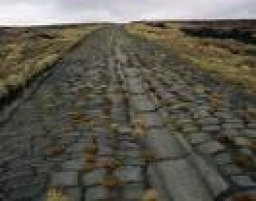
The romans seemed to have used wagons, and wooden ships for transportation.
Roads
Just about 50,000 miles of road spanned the Roman Empire. Rome was a main point for trading, polotics, culture, and military. The roads were designed for military explotions. The Romans Roads were built mainly by the legions themselves. As the empire expanded, the cost of responsibility for building and maintaining the roads were made by locals and tribes rathers than by the Roman treasury itself. This road was huge, it is to be said that someone could go from Spain to Greese without ever having to step off a road. People used horse carrages and/or went on horse back to shorten the travel time.
Why did romans make roads? Actually the main reason was because so much of western Europe conqured by the Romans, they needed roads to move their soldiers around fast, poor roads did not help witht this what so ever. It was said that before the 'new roads' were built, it took people "soldiers" twice as long to get from one place to the other because most of the time they couldn't tell what was road and what wassn't. When they arrived to England, they found there were no roads. They had to use old trails that were made from tribes that lived there before. Some of the Roman Roads are still here today.
The roads weren't made of jsut dirt, they were made with stone and mud. On each side of the road there was a drainage ditch to help get rid of the water from when it rained.
Ships
The city's growing need for supplies ment increasing contact with merchantile trade across the seas. Obviously, this ment a growing need for ships of the least quality. Roman sea trade grew, but so did the protection of their ships
Roads
Just about 50,000 miles of road spanned the Roman Empire. Rome was a main point for trading, polotics, culture, and military. The roads were designed for military explotions. The Romans Roads were built mainly by the legions themselves. As the empire expanded, the cost of responsibility for building and maintaining the roads were made by locals and tribes rathers than by the Roman treasury itself. This road was huge, it is to be said that someone could go from Spain to Greese without ever having to step off a road. People used horse carrages and/or went on horse back to shorten the travel time.
Why did romans make roads? Actually the main reason was because so much of western Europe conqured by the Romans, they needed roads to move their soldiers around fast, poor roads did not help witht this what so ever. It was said that before the 'new roads' were built, it took people "soldiers" twice as long to get from one place to the other because most of the time they couldn't tell what was road and what wassn't. When they arrived to England, they found there were no roads. They had to use old trails that were made from tribes that lived there before. Some of the Roman Roads are still here today.
The roads weren't made of jsut dirt, they were made with stone and mud. On each side of the road there was a drainage ditch to help get rid of the water from when it rained.
Ships
The city's growing need for supplies ment increasing contact with merchantile trade across the seas. Obviously, this ment a growing need for ships of the least quality. Roman sea trade grew, but so did the protection of their ships
Tools and Technology By: Andrew Brandt and Schweegs
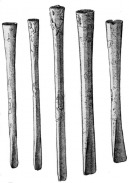
These are chisels used for woodworking in ancient Rome. Chisels were used to shape and sculpt wood or stone for various purposes. These chisels were most likely made of metal--iron or bronze. Sculptors used chisels to shape and define the delicate features of statues. Some chisels had wooden handles to make it easier for the sculptor to use them.
Many things that we use on a day to day basis in 2010 were developed or refined by the Ancient Romans. The width of our roads are based on the width established for roads in the Roman Empire, the size of our railroad tracks correspond with the width of Roman chariot and wagon wheels and many of the tools we use are based on things used by the Romans thousands of years ago. Look at woodworking tools. They used hammers, chisels, axes, planes and lathes in their craftsmanship. The power lathes that we use today are just refinements of the lathes that were used in Ancient Rome.
Their technology was very good and their craftsmanship was excellent, considering that they did not have electric power tools to use. They used hand power, animal power and probably water power where it was available to run their tools.
Archeologists are still finding new types of tools that were used in crafts and work in Ancient Rome.
Many things that we use on a day to day basis in 2010 were developed or refined by the Ancient Romans. The width of our roads are based on the width established for roads in the Roman Empire, the size of our railroad tracks correspond with the width of Roman chariot and wagon wheels and many of the tools we use are based on things used by the Romans thousands of years ago. Look at woodworking tools. They used hammers, chisels, axes, planes and lathes in their craftsmanship. The power lathes that we use today are just refinements of the lathes that were used in Ancient Rome.
Their technology was very good and their craftsmanship was excellent, considering that they did not have electric power tools to use. They used hand power, animal power and probably water power where it was available to run their tools.
Archeologists are still finding new types of tools that were used in crafts and work in Ancient Rome.
Title.
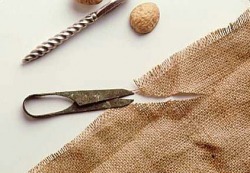
This is a pair of scissiors found in an archeological dig in Rome. It is very similar to scissors of today. The main difference is that instead of being connected in an X shape like most of our scissors are, this pair is connected by a loop in the handle. Scissors are still being made like this today for crafts such as embroidery and needlework. These would be small and easy to take along with a person.
Whether people realize it or not, many of our everyday tools came to us from Ancient Rome.
Whether people realize it or not, many of our everyday tools came to us from Ancient Rome.
Title.
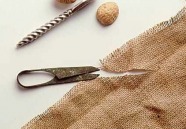
The government during the Roman Republic was controlled mostly by the wealthy. They made up one of the first forms of representative government; the Senate. The Senate is made up of 300 men who were voted in for life by the two counsels. The Senate’s main jobs were to aid the counsels in making decisions, control spending, endorse or veto laws made by the Assembly, and making decisions dealing with foreign rulers.
The Assembly was the only body of their government made up of the common man. This body was not very powerful and was strictly checked by the Senate. The Assembly did have some important jobs though, with the most important one being electing the 2 counsels. This body was also in charge of electing the government representatives and judges, voting on laws recommended by the government representatives, and declared war and peace.
There were many important executive positions in the Roman Republic that were controlled by the wealthy. The two counsels were debatably the most powerful people in Rome. These two men were elected from the Senate by the Assembly to serve for a year. They were in charge of managing the government officials, commanding the army, acting as judges on occasion, and operating the government. There was a catch though. They both had to agree on every option before it could become a law or be edited. Another group of important government people were the magistrates. There was a few of them and they controlled Rome’s financial state, as well as keeping law and order throughout the Republic. Finally, there was a group of men known as tribunes. Their job was to protect the poor people’s rights and make sure they were treated equally. These men also had the power to veto any bill in the Senate that concerned the poor.
Even with the Republic controlled by the wealthy portion of the population, the Republic endured through tough times and was a basis for our style of government today.
" The Government of Rome." History on the net. Historyonthenet, 15 03 2007. Web. 22 Apr 2010. http://www.historyonthenet.com/Romans/government.htm>
"The Government of Rome." History on the net. Historyonthenet, 15 03 2007. Web. 22 Apr 2010. <http://www.historyonthenet.com/Romans/government.htm>.
Carr, Dr. Karen. "Roman Government." Kidipede. Portland State University, 19, Jan 2009. Web. 21 Apr 2010. <http://www.historyforkids.org/learn/romans/government/>.
The Assembly was the only body of their government made up of the common man. This body was not very powerful and was strictly checked by the Senate. The Assembly did have some important jobs though, with the most important one being electing the 2 counsels. This body was also in charge of electing the government representatives and judges, voting on laws recommended by the government representatives, and declared war and peace.
There were many important executive positions in the Roman Republic that were controlled by the wealthy. The two counsels were debatably the most powerful people in Rome. These two men were elected from the Senate by the Assembly to serve for a year. They were in charge of managing the government officials, commanding the army, acting as judges on occasion, and operating the government. There was a catch though. They both had to agree on every option before it could become a law or be edited. Another group of important government people were the magistrates. There was a few of them and they controlled Rome’s financial state, as well as keeping law and order throughout the Republic. Finally, there was a group of men known as tribunes. Their job was to protect the poor people’s rights and make sure they were treated equally. These men also had the power to veto any bill in the Senate that concerned the poor.
Even with the Republic controlled by the wealthy portion of the population, the Republic endured through tough times and was a basis for our style of government today.
" The Government of Rome." History on the net. Historyonthenet, 15 03 2007. Web. 22 Apr 2010. http://www.historyonthenet.com/Romans/government.htm>
"The Government of Rome." History on the net. Historyonthenet, 15 03 2007. Web. 22 Apr 2010. <http://www.historyonthenet.com/Romans/government.htm>.
Carr, Dr. Karen. "Roman Government." Kidipede. Portland State University, 19, Jan 2009. Web. 21 Apr 2010. <http://www.historyforkids.org/learn/romans/government/>.
Roman Republic Government – Molly and Kassidy
The government during the Roman Republic was controlled mostly by the wealthy. They made up one of the first forms of representative government; the Senate. The Senate is made up of 300 men who were voted in for life by the two counsels. The Senate’s main jobs were to aid the counsels in making decisions, control spending, endorse or veto laws made by the Assembly, and making decisions dealing with foreign rulers.
The Assembly was the only body of their government made up of the common man. This body was not very powerful and was strictly checked by the Senate. The Assembly did have some important jobs though, with the most important one being electing the 2 counsels. This body was also in charge of electing the government representatives and judges, voting on laws recommended by the government representatives, and declared war and peace.
There were many important executive positions in the Roman Republic that were controlled by the wealthy. The two counsels were debatably the most powerful people in Rome. These two men were elected from the Senate by the Assembly to serve for a year. They were in charge of managing the government officials, commanding the army, acting as judges on occasion, and operating the government. There was a catch though. They both had to agree on every option before it could become a law or be edited. Another group of important government people were the magistrates. There was a few of them and they controlled Rome’s financial state, as well as keeping law and order throughout the Republic. Finally, there was a group of men known as tribunes. Their job was to protect the poor people’s rights and make sure they were treated equally. These men also had the power to veto any bill in the Senate that concerned the poor.
Even with the Republic controlled by the wealthy portion of the population, the Republic endured through tough times and was a basis for our style of government today.
" The Government of Rome." History on the net. Historyonthenet, 15 03 2007. Web. 22 Apr 2010. http://www.historyonthenet.com/Romans/government.htm>
"The Government of Rome." History on the net. Historyonthenet, 15 03 2007. Web. 22 Apr 2010. <http://www.historyonthenet.com/Romans/government.htm>.
Carr, Dr. Karen. "Roman Government." Kidipede. Portland State University, 19, Jan 2009. Web. 21 Apr 2010. <http://www.historyforkids.org/learn/romans/government/>.
The Assembly was the only body of their government made up of the common man. This body was not very powerful and was strictly checked by the Senate. The Assembly did have some important jobs though, with the most important one being electing the 2 counsels. This body was also in charge of electing the government representatives and judges, voting on laws recommended by the government representatives, and declared war and peace.
There were many important executive positions in the Roman Republic that were controlled by the wealthy. The two counsels were debatably the most powerful people in Rome. These two men were elected from the Senate by the Assembly to serve for a year. They were in charge of managing the government officials, commanding the army, acting as judges on occasion, and operating the government. There was a catch though. They both had to agree on every option before it could become a law or be edited. Another group of important government people were the magistrates. There was a few of them and they controlled Rome’s financial state, as well as keeping law and order throughout the Republic. Finally, there was a group of men known as tribunes. Their job was to protect the poor people’s rights and make sure they were treated equally. These men also had the power to veto any bill in the Senate that concerned the poor.
Even with the Republic controlled by the wealthy portion of the population, the Republic endured through tough times and was a basis for our style of government today.
" The Government of Rome." History on the net. Historyonthenet, 15 03 2007. Web. 22 Apr 2010. http://www.historyonthenet.com/Romans/government.htm>
"The Government of Rome." History on the net. Historyonthenet, 15 03 2007. Web. 22 Apr 2010. <http://www.historyonthenet.com/Romans/government.htm>.
Carr, Dr. Karen. "Roman Government." Kidipede. Portland State University, 19, Jan 2009. Web. 21 Apr 2010. <http://www.historyforkids.org/learn/romans/government/>.
Title.

Paragraph.
Health and Medicine
By: Kelcey Olson

This is a rash caused by the Measles virus
Life Expectancy
The average life expectancy of people in todays world is 82 but during the Roman Republic the average life expectancy was 35 years. That is a 47 year difference which is crazy, but most of the deaths that brought that age down are because of the infant mortality. In the time of 531 B.C.E. -31 B.C.E. most babies would die before their 1st birthday. Most of these deaths are caused by inherited diseases or birth defects. Babies in the Roman Republic were very likely to die from what seem like little things to the modern day like diarrhea, because of the weak bodies. Of the kids that lived past one, half of them died before the age of ten.
Common Diseases
During the Roman Republic the death of many people is because of the diseases that they suffered from. The use of swampy marshlands and groundwater caused the death of some 40,000 romans. These conditions were the perfect breeding ground for mosquitoes which carried the malaria bacteria. Malaria will cause the infected to have a fever, chills, and many flu like symptoms. It was recognized when it began to kill many people in the toman city-states. They linked it to certain bug bites and swamps. Another way that the spread of bacteria and germs was caused by the communal bucket of salt water that the roman citizens used to wash themselves, along with a communal sponge that aided in the spread.
Typhoid Fever, Epilepsy, and Measles are also diseases that were very common and deadly during this time. Epilepsy is a series of unprovoked seizures, caused by neurological problems. Doctors of this time didn't have the schooling or the technology that we do today therefore trying to help people control their seizures was impossible 98% of the people that had epilepsy during this time died from it. Measles is a virus which means that it can't be cured by any antibiotics or any medicines that they may of had at this time. It made the skin itchy, and gave the sick a rash, fever, cough, runny nose, and pink eye. Measles is highly contagious and will gradually get worse and worse, it begins with blindness and works its way to death. Typhoid Fever was transmitted by food contaminated by feces or by passing from an infected person. Typhoid fever symptoms are a fever of around 104 degrees, profuse sweating, diarrhea, and occasionally a rash. These diseases have been the cause of death in not only young children of the republic but also of the adults. Many of the parents actually the parents often spread the disease.
Childbirth
The Roman times and culture weren't much different from what we see today. During this time the men were given credit for pretty much everthing that happens, in this case even the conception of a baby was giving to the men. They would say that the womb was just there to recieve all the important information that the sprem cell was supposed to have carried. Birth control is something that many women today use so they are protected from pregnancy, well during the time period of the roman republic the women used a plant called siphium, which would actually terminate any pregnancy. This was thought to be very helpful for many women who didn't want or couldn't have a healthy kid. For those women who did have children most were born naturally, through the birth canal but for some there was complications and a Caesaren Section was needed. Despite what the biggest belief are Julius Caesars mother did not have C-section when giving birth to Caesar. It is called the Caesaren Section because under the Caesarean law it says "if a woman died during childbirth she couldn't be buried with out the removal of her baby, hence the name. Researchers have found the fact about Julius Ceasar false because at this time if a woman was to undergo a C-section she would die but in fact Ceasar's mom lived till he was much older.
Coinage By:Kelcey Olson
In its early stages Rome was mainly a trading society they just traded and bareded with eachother. But as Rome began to grow they started using lumps of bronze and other metals. They called these lumps Aes Rude (raw bronze). The first true Roman coin however was the Aes Signatum(signed bronze). The Aes Signatum was made the same size and each coin weighed about 1600 grams so the traders didn't have to worry about being cheated. Only a few years after the Aes Signatum, the Aes Grave (heavy bronze) began to be more useful, around 269 B.C. These were made into smaller coins making trade easier, they were stamped with exotic animals or gods, and a ships prow. At this time the basic unit of currency was called an As. Around the same time was silver coinage, the romans got the idea of using silver from the greeks. The 1st silver coins produced were didrachms, but were soon replaced by a coin that weighed only 3.4 grams called victoriatus. The new and improved silver coins , the Denarius, was valued around 10 As. Roman coinage has come along way since this time but it all has to start some where.
Shops By:Kelcey Olson
Shops during the Roman Republic time were common, most were the front part of peoples homes. Many shops were just one big room called a tabernae, others had rooms in the back for storage or maybe even a meeting room. The via Sacra had shops, the Vicustusaus is said to be where most spices were sold, the Argiletum was the home of book and shoe shops. The eastern part of Rome was the poor mans shop. It sold products that were better suited for the less fortunate people. The Velabrum, or general market was most known because it fed most of the city. The weathly romans go to shops in campus martuis where one would find more luxiorious shops.
Roman Calendar-By:Kelcey Olson
Calends- 1st day of everymonth
Ides- 15th day of every month containging 31 days
Nones- 9 days before Ides, 5th or 7th of the month.
Januarius -- 29 days
Februarius -- 28
Martius --31
Aprilis -- 29
Maius -- 31
Junius -- 29
Quintilis -- 31
Sextilis -- 29
September -- 29
October -- 31
November -- 29
December -- 29
(The Roman Republic Calendar still had the same 12 months but lengths of each month vary.)
-- Carr, Dr. Karen. "Ancient Life expectancy." Kidipedia. N.p., 01-15-09. Web. 25 Apr 2010. <http://www.historyforkids.org/learn/people/lifeexpectancy.htm>.
-- Hagen, karl. "The Roman Republican Calendar." Polysyllabic. creative commons attribution, 02-16-10. Web. 25 Apr 2010. <http://www.polysyllabic.com/?q=calhistory/earlier/roman>.
-- "Shops." SPQR online. Think quest team, 08-24-09. Web. 25 Apr 2010. <http://library.thinkquest.org/26602/republic.htm>.
-- "Roman Calendar." UNRV History. N.p., 4-27-10. Web. 24 Apr 2010. <http://www.unrv.com/culture/roman-calendar.php>.
The average life expectancy of people in todays world is 82 but during the Roman Republic the average life expectancy was 35 years. That is a 47 year difference which is crazy, but most of the deaths that brought that age down are because of the infant mortality. In the time of 531 B.C.E. -31 B.C.E. most babies would die before their 1st birthday. Most of these deaths are caused by inherited diseases or birth defects. Babies in the Roman Republic were very likely to die from what seem like little things to the modern day like diarrhea, because of the weak bodies. Of the kids that lived past one, half of them died before the age of ten.
Common Diseases
During the Roman Republic the death of many people is because of the diseases that they suffered from. The use of swampy marshlands and groundwater caused the death of some 40,000 romans. These conditions were the perfect breeding ground for mosquitoes which carried the malaria bacteria. Malaria will cause the infected to have a fever, chills, and many flu like symptoms. It was recognized when it began to kill many people in the toman city-states. They linked it to certain bug bites and swamps. Another way that the spread of bacteria and germs was caused by the communal bucket of salt water that the roman citizens used to wash themselves, along with a communal sponge that aided in the spread.
Typhoid Fever, Epilepsy, and Measles are also diseases that were very common and deadly during this time. Epilepsy is a series of unprovoked seizures, caused by neurological problems. Doctors of this time didn't have the schooling or the technology that we do today therefore trying to help people control their seizures was impossible 98% of the people that had epilepsy during this time died from it. Measles is a virus which means that it can't be cured by any antibiotics or any medicines that they may of had at this time. It made the skin itchy, and gave the sick a rash, fever, cough, runny nose, and pink eye. Measles is highly contagious and will gradually get worse and worse, it begins with blindness and works its way to death. Typhoid Fever was transmitted by food contaminated by feces or by passing from an infected person. Typhoid fever symptoms are a fever of around 104 degrees, profuse sweating, diarrhea, and occasionally a rash. These diseases have been the cause of death in not only young children of the republic but also of the adults. Many of the parents actually the parents often spread the disease.
Childbirth
The Roman times and culture weren't much different from what we see today. During this time the men were given credit for pretty much everthing that happens, in this case even the conception of a baby was giving to the men. They would say that the womb was just there to recieve all the important information that the sprem cell was supposed to have carried. Birth control is something that many women today use so they are protected from pregnancy, well during the time period of the roman republic the women used a plant called siphium, which would actually terminate any pregnancy. This was thought to be very helpful for many women who didn't want or couldn't have a healthy kid. For those women who did have children most were born naturally, through the birth canal but for some there was complications and a Caesaren Section was needed. Despite what the biggest belief are Julius Caesars mother did not have C-section when giving birth to Caesar. It is called the Caesaren Section because under the Caesarean law it says "if a woman died during childbirth she couldn't be buried with out the removal of her baby, hence the name. Researchers have found the fact about Julius Ceasar false because at this time if a woman was to undergo a C-section she would die but in fact Ceasar's mom lived till he was much older.
Coinage By:Kelcey Olson
In its early stages Rome was mainly a trading society they just traded and bareded with eachother. But as Rome began to grow they started using lumps of bronze and other metals. They called these lumps Aes Rude (raw bronze). The first true Roman coin however was the Aes Signatum(signed bronze). The Aes Signatum was made the same size and each coin weighed about 1600 grams so the traders didn't have to worry about being cheated. Only a few years after the Aes Signatum, the Aes Grave (heavy bronze) began to be more useful, around 269 B.C. These were made into smaller coins making trade easier, they were stamped with exotic animals or gods, and a ships prow. At this time the basic unit of currency was called an As. Around the same time was silver coinage, the romans got the idea of using silver from the greeks. The 1st silver coins produced were didrachms, but were soon replaced by a coin that weighed only 3.4 grams called victoriatus. The new and improved silver coins , the Denarius, was valued around 10 As. Roman coinage has come along way since this time but it all has to start some where.
Shops By:Kelcey Olson
Shops during the Roman Republic time were common, most were the front part of peoples homes. Many shops were just one big room called a tabernae, others had rooms in the back for storage or maybe even a meeting room. The via Sacra had shops, the Vicustusaus is said to be where most spices were sold, the Argiletum was the home of book and shoe shops. The eastern part of Rome was the poor mans shop. It sold products that were better suited for the less fortunate people. The Velabrum, or general market was most known because it fed most of the city. The weathly romans go to shops in campus martuis where one would find more luxiorious shops.
Roman Calendar-By:Kelcey Olson
Calends- 1st day of everymonth
Ides- 15th day of every month containging 31 days
Nones- 9 days before Ides, 5th or 7th of the month.
Januarius -- 29 days
Februarius -- 28
Martius --31
Aprilis -- 29
Maius -- 31
Junius -- 29
Quintilis -- 31
Sextilis -- 29
September -- 29
October -- 31
November -- 29
December -- 29
(The Roman Republic Calendar still had the same 12 months but lengths of each month vary.)
-- Carr, Dr. Karen. "Ancient Life expectancy." Kidipedia. N.p., 01-15-09. Web. 25 Apr 2010. <http://www.historyforkids.org/learn/people/lifeexpectancy.htm>.
-- Hagen, karl. "The Roman Republican Calendar." Polysyllabic. creative commons attribution, 02-16-10. Web. 25 Apr 2010. <http://www.polysyllabic.com/?q=calhistory/earlier/roman>.
-- "Shops." SPQR online. Think quest team, 08-24-09. Web. 25 Apr 2010. <http://library.thinkquest.org/26602/republic.htm>.
-- "Roman Calendar." UNRV History. N.p., 4-27-10. Web. 24 Apr 2010. <http://www.unrv.com/culture/roman-calendar.php>.
Title.

Paragraph.
Roman Republic Government - Molly and Kassidy

The government during the Roman Republic was controlled mostly by the wealthy. They made up one of the first forms of representative government; the Senate. The Senate is made up of 300 men who were voted in for life by the two counsels. The Senate’s main jobs were to aid the counsels in making decisions, control spending, endorse or veto laws made by the Assembly, and making decisions dealing with foreign rulers.
The Assembly was the only body of their government made up of the common man. This body was not very powerful and was strictly checked by the Senate. The Assembly did have some important jobs though, with the most important one being electing the 2 counsels. This body was also in charge of electing the government representatives and judges, voting on laws recommended by the government representatives, and declared war and peace.
The Assembly was the only body of their government made up of the common man. This body was not very powerful and was strictly checked by the Senate. The Assembly did have some important jobs though, with the most important one being electing the 2 counsels. This body was also in charge of electing the government representatives and judges, voting on laws recommended by the government representatives, and declared war and peace.
Executive Postions in the Roman Republic - Molly and Kassidy
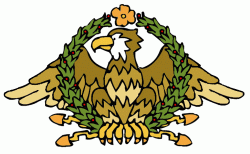
There were many important executive positions in the Roman Republic that were controlled by the wealthy. The two counsels were debatably the most powerful people in Rome. These two men were elected from the Senate by the Assembly to serve for a year. They were in charge of managing the government officials, commanding the army, acting as judges on occasion, and operating the government. There was a catch though. They both had to agree on every option before it could become a law or be edited. Another group of important government people were the magistrates. There was a few of them and they controlled Rome’s financial state, as well as keeping law and order throughout the Republic. Finally, there was a group of men known as tribunes. Their job was to protect the poor people’s rights and make sure they were treated equally. These men also had the power to veto any bill in the Senate that concerned the poor.
Even with the Republic controlled by the wealthy portion of the population, the Republic endured through tough times and was a basis for our style of government today.
" The Government of Rome." History on the net. Historyonthenet, 15 03 2007. Web. 22 Apr 2010. http://www.historyonthenet.com/Romans/government.htm>
"The Government of Rome." History on the net. Historyonthenet, 15 03 2007. Web. 22 Apr 2010. <http://www.historyonthenet.com/Romans/government.htm>.
Carr, Dr. Karen. "Roman Government." Kidipede. Portland State University, 19, Jan 2009. Web. 21 Apr 2010. <http://www.historyforkids.org/learn/romans/government/>.
Even with the Republic controlled by the wealthy portion of the population, the Republic endured through tough times and was a basis for our style of government today.
" The Government of Rome." History on the net. Historyonthenet, 15 03 2007. Web. 22 Apr 2010. http://www.historyonthenet.com/Romans/government.htm>
"The Government of Rome." History on the net. Historyonthenet, 15 03 2007. Web. 22 Apr 2010. <http://www.historyonthenet.com/Romans/government.htm>.
Carr, Dr. Karen. "Roman Government." Kidipede. Portland State University, 19, Jan 2009. Web. 21 Apr 2010. <http://www.historyforkids.org/learn/romans/government/>.
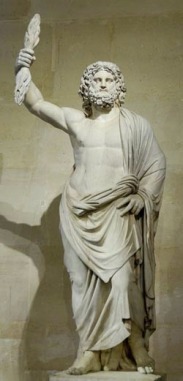
Paragraph.
Roman religion
By: Aurelia and Kristin
Roman religion was made up of mythology, but Numen was the most common thing that Romans believe. Numen is the belief that there is a power of either a deity or a spirit that is present in places and objects. Also there is not a month in the roman calendar that did not have a religious festivals. This just shows how the roman people worshiped the roman gods and goddesses. Romans had not only a pantheon but also had a household cult of the dii familiaris. In the belief it said that each person in the household had a guardian spirit assigned to them, known as the lar familiaris. These spirits played a important role in there lives, genii were for men and junii were for women. These deities stayed with the person for there whole life. The Romans believed that these spirits had control over there growth, learning abilities, and the ability to behave morally within society. Roman gods and goddesses were a blend of several religious influences, all of which were introduced by the Greek colonies of southern Italy. But in the east the Greek names remained the choice of the people and the major gods of the system therefore, were known by both. Foreign gods and customs not only played a major role but were also given temples and priesthoods within Rome. It was not till the passing of roman republic that the emperors themselves were being included with the gods. Julius Caesar had claimed himself to be a direct descent of aeneas. But at first it seem taboo for the people but the popularity of Caesar made it easier for people to except and made other emperors be worship with the gods.
There are many festivals in the Roman republic. Like the festivals for Juturna, the goddess of healing, to the Festival of Hercules.
January
On January first they have the Festival of Janus, which is the a two faced god of the beginnings.
On January fifth is the birthday of the god Vica Pota, she is the goddess of the victory.
Also in January they celebrate the Festival of Juturna, she is the goddess of healing.
February
On the first the Romans celebrated the Festival of Juno Sospita.
On the twenty third of February they honor the boundary god, Terminus.
Also in February they honor the horse rider Mars.
March
On the seventh day in March they have a festival for Vediovis, which is an underworld version of Jupiter.
On the nineteenth of March the Romans have a five day festival, in honor of Minerva and Mars.
On the thirty first of March they honor the goddess Luna. She is the goddess of the moon.
April
On the fifth day in April they hold a festival of Fortuna Publica, which means “luck of the people.”
On the twenty third of April they have a festival for wine production in of the god of Jupiter.
From April twenty eighth to May third they hold a Flower festival for spring fertility.
May
They hold a Festival to Jupiter and Mercury.
June
On the third of June they hold a festival for Bellona; she is the goddess of war.
On the forth of June they have another festival for Hercules.
On the twenty fifth of June, every four years the hold Turian games, for the underworld gods.
July
From the Sixth to the thirteenth of July they have games, to honor Apollo.
On the twentieth of July they held games for the victories Caesar and the goddess Victoria.
Then on the twenty fifth they have a festival for the spring goddess Furrina.
August
In August they held a festival for the goddess of health, Salus.
On the Ninth they hold another festival for the god of sun, Sol.
Then on the twenty first they held a festival for the god of agricultural, Consus.
September
From the fifth to the nineteenth of Sep. they held games for Jupiter Optimus Maximas.
Then on the twenty sixth of Sep. they had a festival for Venus Genetrix, Venus is the god of Roman People.
October
On the tenth of October they held a festival for the god of Juno.
On the fourteenth of October they held festival for domestic patron god, Penates.
November
The forth threw the seventeenth they held games in honor of Jupiter. On the thirteenth was the highpoint of the games.
On the Eighteenth they hold a festival a Gallic horse goddess, Epona.
On the twenty fifth they held midwinter solstice.
"Republican era State festivals."
http://www.unrv.com/culture/roman-festivals.php. N.p., 2003. Web. 30 Apr 2010.
http://www.com/culture/roman-religion.php, 2003, web.30 apr2010
By: Aurelia and Kristin
Roman religion was made up of mythology, but Numen was the most common thing that Romans believe. Numen is the belief that there is a power of either a deity or a spirit that is present in places and objects. Also there is not a month in the roman calendar that did not have a religious festivals. This just shows how the roman people worshiped the roman gods and goddesses. Romans had not only a pantheon but also had a household cult of the dii familiaris. In the belief it said that each person in the household had a guardian spirit assigned to them, known as the lar familiaris. These spirits played a important role in there lives, genii were for men and junii were for women. These deities stayed with the person for there whole life. The Romans believed that these spirits had control over there growth, learning abilities, and the ability to behave morally within society. Roman gods and goddesses were a blend of several religious influences, all of which were introduced by the Greek colonies of southern Italy. But in the east the Greek names remained the choice of the people and the major gods of the system therefore, were known by both. Foreign gods and customs not only played a major role but were also given temples and priesthoods within Rome. It was not till the passing of roman republic that the emperors themselves were being included with the gods. Julius Caesar had claimed himself to be a direct descent of aeneas. But at first it seem taboo for the people but the popularity of Caesar made it easier for people to except and made other emperors be worship with the gods.
There are many festivals in the Roman republic. Like the festivals for Juturna, the goddess of healing, to the Festival of Hercules.
January
On January first they have the Festival of Janus, which is the a two faced god of the beginnings.
On January fifth is the birthday of the god Vica Pota, she is the goddess of the victory.
Also in January they celebrate the Festival of Juturna, she is the goddess of healing.
February
On the first the Romans celebrated the Festival of Juno Sospita.
On the twenty third of February they honor the boundary god, Terminus.
Also in February they honor the horse rider Mars.
March
On the seventh day in March they have a festival for Vediovis, which is an underworld version of Jupiter.
On the nineteenth of March the Romans have a five day festival, in honor of Minerva and Mars.
On the thirty first of March they honor the goddess Luna. She is the goddess of the moon.
April
On the fifth day in April they hold a festival of Fortuna Publica, which means “luck of the people.”
On the twenty third of April they have a festival for wine production in of the god of Jupiter.
From April twenty eighth to May third they hold a Flower festival for spring fertility.
May
They hold a Festival to Jupiter and Mercury.
June
On the third of June they hold a festival for Bellona; she is the goddess of war.
On the forth of June they have another festival for Hercules.
On the twenty fifth of June, every four years the hold Turian games, for the underworld gods.
July
From the Sixth to the thirteenth of July they have games, to honor Apollo.
On the twentieth of July they held games for the victories Caesar and the goddess Victoria.
Then on the twenty fifth they have a festival for the spring goddess Furrina.
August
In August they held a festival for the goddess of health, Salus.
On the Ninth they hold another festival for the god of sun, Sol.
Then on the twenty first they held a festival for the god of agricultural, Consus.
September
From the fifth to the nineteenth of Sep. they held games for Jupiter Optimus Maximas.
Then on the twenty sixth of Sep. they had a festival for Venus Genetrix, Venus is the god of Roman People.
October
On the tenth of October they held a festival for the god of Juno.
On the fourteenth of October they held festival for domestic patron god, Penates.
November
The forth threw the seventeenth they held games in honor of Jupiter. On the thirteenth was the highpoint of the games.
On the Eighteenth they hold a festival a Gallic horse goddess, Epona.
On the twenty fifth they held midwinter solstice.
"Republican era State festivals."
http://www.unrv.com/culture/roman-festivals.php. N.p., 2003. Web. 30 Apr 2010.
http://www.com/culture/roman-religion.php, 2003, web.30 apr2010
Interesting and Random Facts About Julius Cearsar
By Vincent Raia
1. He was the first to print his own bust on roman minted coins
2. When going to Greece for more studies, he was captured by Cilican pirates
3. He presudaed a king Birthynia to sleep with him
4. He entrusted his will and testaments to the oldest of the vestal virgins
5. He Was Not An Empror but a Dictator Perepetuus
6. He invented the slogan veni, vidi ,vici (I came, I saw, I overcame)
7. He was the last Roman Dictator
8. He got married 3 times and had an affair with Cleopatura 4th
Sources:
"93 Random Roman Facts." Random Facts. Random History.com, 2010. Web. 30 Apr 2010. <http://facts.randomhistory.com/2009/03/07_rome.html>.
"Julius Caesar." Roman-Colosseum Info. Roman Colosseum, 2008. Web. 30 Apr 2010. <http://www.roman-colosseum.info/roman-empire/julius-caesar.htm>.
McManus, Barbara. "Julius Caesar: Historical Background." Barbara F. McManus. College of New Rochelle, Aug 2009. Web. 30 Apr 2010. <http://www.vroma.org/~bmcmanus/caesar.html>.
By Vincent Raia
1. He was the first to print his own bust on roman minted coins
2. When going to Greece for more studies, he was captured by Cilican pirates
3. He presudaed a king Birthynia to sleep with him
4. He entrusted his will and testaments to the oldest of the vestal virgins
5. He Was Not An Empror but a Dictator Perepetuus
6. He invented the slogan veni, vidi ,vici (I came, I saw, I overcame)
7. He was the last Roman Dictator
8. He got married 3 times and had an affair with Cleopatura 4th
Sources:
"93 Random Roman Facts." Random Facts. Random History.com, 2010. Web. 30 Apr 2010. <http://facts.randomhistory.com/2009/03/07_rome.html>.
"Julius Caesar." Roman-Colosseum Info. Roman Colosseum, 2008. Web. 30 Apr 2010. <http://www.roman-colosseum.info/roman-empire/julius-caesar.htm>.
McManus, Barbara. "Julius Caesar: Historical Background." Barbara F. McManus. College of New Rochelle, Aug 2009. Web. 30 Apr 2010. <http://www.vroma.org/~bmcmanus/caesar.html>.
Law and Justice
by
Jesus Garcia
The main laws followed back during the roman empire were the twelve tables. A few examples of the twelve rables are table I. Mandates that when a person is accused of something, the accused and the accuser must show up to court, and if the accused does not show up the accuser is allowed to take him by force and table IX which states that any judge who is caught taking bribes and any person who commits treason shall shall be sentenced to death. These tables are kind of like the Ten Commandments of the Christian religion. Roman law has influenced the development of law in most of the western civilization today. It dealt with matters of succession (or inheritance), obligation (including contracts), property (including slaves), and people. Most laws were passed through assemblies dominated by patricians, though the rulings of magistrates were also important. Roman law developed the division between public law, which dealt with matters such and bribary and treason, and private law, such as disputes over property.
Sources:
www.crystalinks.com/romelaw.html
www.fordham.edu/halsall/ancient/12tables.html
by
Jesus Garcia
The main laws followed back during the roman empire were the twelve tables. A few examples of the twelve rables are table I. Mandates that when a person is accused of something, the accused and the accuser must show up to court, and if the accused does not show up the accuser is allowed to take him by force and table IX which states that any judge who is caught taking bribes and any person who commits treason shall shall be sentenced to death. These tables are kind of like the Ten Commandments of the Christian religion. Roman law has influenced the development of law in most of the western civilization today. It dealt with matters of succession (or inheritance), obligation (including contracts), property (including slaves), and people. Most laws were passed through assemblies dominated by patricians, though the rulings of magistrates were also important. Roman law developed the division between public law, which dealt with matters such and bribary and treason, and private law, such as disputes over property.
Sources:
www.crystalinks.com/romelaw.html
www.fordham.edu/halsall/ancient/12tables.html
Inequality of the Roman Republic by Brady Ysker-Giefer
Inequality of the Roman Republic by Brady Ysker-Giefer
Inequality of the Roman Republic
By: Brady Ysker-Giefer
Plebians v. Patricians
In the beginning of the Roman Republic, it is said that a constitution was created which maintained tradition and created institutions for the Republic. This constitution was, in all actuality, not even a written document, but instead was a series of unwritten laws and traditions. During this time, although they did not recreate the monarchy, Romans spent much time on choosing their political leaders. At the top of the totem pole were consuls. There were two consuls elected per year to exercise imperium much like the Roman kings had previously. However, unlike kings, these consuls had terms of agreement in which they could only function under certain rules, much like the checks and balances of our government today.
Lower than the superiority of the consuls were two financial officers known as quaestors, later known as praetors. Originally, praetorship was a judicial office however, it later became a military office. Praetors, in effect, were the central generals of Rome. At first, praetors had the duty of classifying citizens in categories such as wealth and tax status was the duty of consuls. This job later fell to a group of people called censors. It was the job of censors to draw up the rolls of citizens and fix their tax status. Because of problems with the censors ability to bribe the public, the office later fell to the most incorruptible men of Rome, former consuls.
Because consuls, quaestors, and praestors were elected directly from the patricianal class of Rome (and former consuls became censors) it is obvious that the patricianal class had dominance over the Roman Republic. The conflict at this time is called the struggle for orders. While patricians maintained and kept pushing for more political power, plebians were attempting to achieve social and political equality. Also, Patricians found it impossible to exist without the aid of the plebians. The plebian calss were the producers of food, supplied the labor that kept the Roman economic ball rolling, and provided soldiers for the Roman military. Together, if the Plebians gathered, they could easily shut down the Roman economic system and military force. Also, military force was especially important due to the continual military conflicts during the era.
It is said that 494 B.C.E. the plebian group left the Republic and declared and alternative government on Sacred Mount. There, the formed a tribal assembly which looked much like the Roman assembly. They set up laws and a checks and balances system.
In 450 B.C.E., the struggle of the orders created the Law of Twelve Tables. This formalized Roman law and the Roman constitution. It was seen as a victory for the rights of Romans citizens because it gave them the ability to know where they stood in social class as far as Roman law went.
In 445 B.C.E. plebians achieved the right to marry a patrician and in 367 B.C.E. they achieved the ability to be elected consul. During the term of the first plebian, the Licinian-Sextian laws were created which ordered that at least one of the consuls must be plebian.
By 300 B.C.E. plebians were allowed to serve at every level of priesthood possible. This brought religious equality between the patricians and plebians and in 287 B.C.E., the plebian assembly decisions became binding for the entire Roman Republic.
Slavery
Slavery in ancient Rome was very important for the economy and social fabric of the Roman culture. During the Republic, the slave population was said to be anywhere from twenty-five to forty percent of the population. Considering that the population was 350,000 to 900,000, this means that there were very many slaves. The issue of slavery drove decisions on policies.
It is said that there are five causes of slavery. First, because of Rome’s conquest to capture Western Europe, millions of slaves were sent to the Italy region. Roman laws was set up so that fathers could sell their children as slaves if they were in need of money. Third, some Romans put themselves into the lives of slavery to pay off debt. Fourth, slave market auctions were held and anyone could buy. Fifth, if a child is born with both a slave mother and father, they are also a slave.
For trade, slaves were sold and slave-markets. The merchants that ran these trades were known as Mangones, and they exposed the slaves naked so to put on a show hanging scrolls of qualities around the slaves’ necks.
Slaves were used for farming, housework, industry, being gladiators, and working in small workshops. Enormous slave plantations could be found in Rome which were owned by the elite Romans. Some highly regarded slaves did housework in rich and middle class homes. The slaves with the hardest lives worked in mines, military workshops, and state industries. They spend nearly all their time in cramped and hazardous conditions. Also, some worked making leather, silver goods, or pots and pans in small workshops. Some slaves were used as professional fighters that fought against each other and even wild animals for entertainment.
Ways to gain freedom were to be given it by the owner and to raise money to buy freedom (virtually impossible). If slaves escaped, authorities could be called to help and catch the fugitive. If the runaway was caught, they would be crucified. Also, Rome allowed slaves to marry, however they got no protection under the law. However, masters preferred married slaves so that they could acquire more investments and property with the ability to sell the children.
Women
In Roman higher classes, families were defined according to male activities rather than birth. Therefore, women in these classes had much lower prominence. In the lower classes, where it was not defined by male activities, there were not many problems at all with including women.
Classes
In summary the Roman Republic consisted of a higher class and a lower class, each with separate rankings. Senators and wealthy men known as equestrians would be known as part of the higher class. Rankings in the lower class consisted of Commons (such as plebians), Latins (freeborn citizens of Italy who did not have full Roman citizenship), Foreigners, Freed people (previous slaves), and lastly, the slaves.
In the beginning of the Roman Republic, it is said that a constitution was created which maintained tradition and created institutions for the Republic. This constitution was, in all actuality, not even a written document, but instead was a series of unwritten laws and traditions. During this time, although they did not recreate the monarchy, Romans spent much time on choosing their political leaders. At the top of the totem pole were consuls. There were two consuls elected per year to exercise imperium much like the Roman kings had previously. However, unlike kings, these consuls had terms of agreement in which they could only function under certain rules, much like the checks and balances of our government today.
Lower than the superiority of the consuls were two financial officers known as quaestors, later known as praetors. Originally, praetorship was a judicial office however, it later became a military office. Praetors, in effect, were the central generals of Rome. At first, praetors had the duty of classifying citizens in categories such as wealth and tax status was the duty of consuls. This job later fell to a group of people called censors. It was the job of censors to draw up the rolls of citizens and fix their tax status. Because of problems with the censors ability to bribe the public, the office later fell to the most incorruptible men of Rome, former consuls.
Because consuls, quaestors, and praestors were elected directly from the patricianal class of Rome (and former consuls became censors) it is obvious that the patricianal class had dominance over the Roman Republic. The conflict at this time is called the struggle for orders. While patricians maintained and kept pushing for more political power, plebians were attempting to achieve social and political equality. Also, Patricians found it impossible to exist without the aid of the plebians. The plebian calss were the producers of food, supplied the labor that kept the Roman economic ball rolling, and provided soldiers for the Roman military. Together, if the Plebians gathered, they could easily shut down the Roman economic system and military force. Also, military force was especially important due to the continual military conflicts during the era.
It is said that 494 B.C.E. the plebian group left the Republic and declared and alternative government on Sacred Mount. There, the formed a tribal assembly which looked much like the Roman assembly. They set up laws and a checks and balances system.
In 450 B.C.E., the struggle of the orders created the Law of Twelve Tables. This formalized Roman law and the Roman constitution. It was seen as a victory for the rights of Romans citizens because it gave them the ability to know where they stood in social class as far as Roman law went.
In 445 B.C.E. plebians achieved the right to marry a patrician and in 367 B.C.E. they achieved the ability to be elected consul. During the term of the first plebian, the Licinian-Sextian laws were created which ordered that at least one of the consuls must be plebian.
By 300 B.C.E. plebians were allowed to serve at every level of priesthood possible. This brought religious equality between the patricians and plebians and in 287 B.C.E., the plebian assembly decisions became binding for the entire Roman Republic.
Slavery
Slavery in ancient Rome was very important for the economy and social fabric of the Roman culture. During the Republic, the slave population was said to be anywhere from twenty-five to forty percent of the population. Considering that the population was 350,000 to 900,000, this means that there were very many slaves. The issue of slavery drove decisions on policies.
It is said that there are five causes of slavery. First, because of Rome’s conquest to capture Western Europe, millions of slaves were sent to the Italy region. Roman laws was set up so that fathers could sell their children as slaves if they were in need of money. Third, some Romans put themselves into the lives of slavery to pay off debt. Fourth, slave market auctions were held and anyone could buy. Fifth, if a child is born with both a slave mother and father, they are also a slave.
For trade, slaves were sold and slave-markets. The merchants that ran these trades were known as Mangones, and they exposed the slaves naked so to put on a show hanging scrolls of qualities around the slaves’ necks.
Slaves were used for farming, housework, industry, being gladiators, and working in small workshops. Enormous slave plantations could be found in Rome which were owned by the elite Romans. Some highly regarded slaves did housework in rich and middle class homes. The slaves with the hardest lives worked in mines, military workshops, and state industries. They spend nearly all their time in cramped and hazardous conditions. Also, some worked making leather, silver goods, or pots and pans in small workshops. Some slaves were used as professional fighters that fought against each other and even wild animals for entertainment.
Ways to gain freedom were to be given it by the owner and to raise money to buy freedom (virtually impossible). If slaves escaped, authorities could be called to help and catch the fugitive. If the runaway was caught, they would be crucified. Also, Rome allowed slaves to marry, however they got no protection under the law. However, masters preferred married slaves so that they could acquire more investments and property with the ability to sell the children.
Women
In Roman higher classes, families were defined according to male activities rather than birth. Therefore, women in these classes had much lower prominence. In the lower classes, where it was not defined by male activities, there were not many problems at all with including women.
Classes
In summary the Roman Republic consisted of a higher class and a lower class, each with separate rankings. Senators and wealthy men known as equestrians would be known as part of the higher class. Rankings in the lower class consisted of Commons (such as plebians), Latins (freeborn citizens of Italy who did not have full Roman citizenship), Foreigners, Freed people (previous slaves), and lastly, the slaves.
Slave Trade Auction
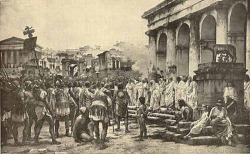
Brady Ysker-Giefer: Reference List
McManus, Barbara. "Imperial Domus." Social Class and Public Display. N.p., 01 Jan 2009. Web. 27 May 2010. http://www.vroma.org/~bmcmanus/socialclass.html.
"Aldokkan." Comparison between Egyptian and Roman Slavery. N.p., 01 Jan 2001. Web. 25 April 2010. http://www.aldokkan.com/society/slavery.htm.
"RosenblumTV." Slavery, Rome, and the Internet. N.p., 13 Jul 2009. Web. April 27 2010. <http://www.rosenblumtv.com/?p=3429>.
Hooker, Richard. "Rome." The Roman Republic. N.p., 01 Jan 1996. Web. 27 April 2010. <http://www.wsu.edu/~dee/ROME/REPUBLIC.HTM>.
"Aldokkan." Comparison between Egyptian and Roman Slavery. N.p., 01 Jan 2001. Web. 25 April 2010. http://www.aldokkan.com/society/slavery.htm.
"RosenblumTV." Slavery, Rome, and the Internet. N.p., 13 Jul 2009. Web. April 27 2010. <http://www.rosenblumtv.com/?p=3429>.
Hooker, Richard. "Rome." The Roman Republic. N.p., 01 Jan 1996. Web. 27 April 2010. <http://www.wsu.edu/~dee/ROME/REPUBLIC.HTM>.
